2016 NFL Draft Snaps: Connor Cook's long-term future bright despite fall

Musings, observations and the occasional insight as we wrap up rounds four through seven of the 2016 NFL draft on Saturday in Chicago...
• Connor Cook was surprisingly forced to wait until day three of this year’s draft just to hear his name called, and now he might have to wait somewhere along the lines of three years to get a legitimate crack at a starting quarterback job in the NFL. That may be the stark reality of Cook’s situation, after the polarizing former Michigan State star lasted until the second pick of the fourth round (100th overall) before the Oakland Raiders stopped his free-fall, making him the seventh passer drafted this year.
That’s right, the Raiders. The team that already has a young and ascending No. 1 quarterback in Derek Carr, who was a second-round pick in 2014. Cook isn’t headed to Oakland to compete with Carr, he’s there to at best push Matt McGloin for the backup job. But here’s hoping Cook’s long wait on draft weekend allows him to take the long view when it comes to his NFL opportunity. Because if he’s patient and puts in the work, something really good might just come from his draft disappointment.
• NFL draft 2016: Complete list of all 263 picks
And for inspiration, Cook has only to look at his highly successful predecessor at Michigan State, Kirk Cousins. It was just four short years ago that Cousins lasted longer in the draft than he cared to, going early in the fourth round to Washington at pick No. 102, almost the same exact slot as Cook. And just like Saturday’s developments, Cousins was drafted into what appeared to be a career dead end, going to Washington exactly 100 picks after the franchise had given up a bonanza of choices for the right to select Baylor quarterback Robert Griffin III.
2016 NFL Draft Snaps: Jags' picks have them on cusp of big turnaround
We all know the rest of that story. Griffin won the NFL’s Offensive Rookie of the Year honor that season, but by 2015 was relegated to the bench and now is trying to re-start his once-sensational career in the quarterback graveyard that is Cleveland. Cousins had to wait until his third season to get a true shot at the No. 1 job in Washington, but he blossomed last year and received the team’s franchise tag earlier this off-season, keeping him off the free-agent market with a one-year price tag of $19.95 million—the second-highest base salary in the league in 2016.
The lesson is clear: Being taken by Oakland in the fourth round does not necessarily equal the end of Cook’s NFL starting dreams. But it in all likelihood will delay them, which is a scenario that Cook could ultimately turn to his advantage. And the same is true for the Raiders, who gave up fourth (114th) and fifth-round picks (154th) to Cleveland in order to move up 14 slots and nab Cook just ahead of quarterback-seeking teams like Dallas (No. 101) and Kansas City (No. 105).
• NFL draft grades: Assessing the classes of all 32 teams
With Carr firmly entrenched as the starter in Oakland, Raiders general manager Reggie McKenzie was likely executing a move he learned in Green Bay from ex-Packers GM Ron Wolf, who habitually drafted young quarterbacks in order to develop them and then reap a reward in trade value (see Matt Hasselbeck, Mark Brunell and Aaron Brooks). In a league where there are never enough starting-caliber passers, Cook could be a valuable commodity in a couple of years, earning the Raiders a return in trade that exceeds their initial fourth-round investment.
2016 NFL draft grades: Analysis of second-round picks
Or at the very least, Cook could become one of the league’s stronger backups, offering an improving Oakland team a key insurance policy should Carr get injured or in any way struggle to follow up on his strong showing over his first two seasons. (Think 2014 fifth-round pick A.J. McCarron in Cincinnati). Either way, the Raiders showed me they recognized Cook’s long-term value and potential, and weren’t going to let their current quarterback depth chart keep them from making a move that could take years to pay benefits. But the shrewdest NFL front offices are always approaching the draft with that kind of foresight, and not just a needs-first, today-is-all-that-matters mentality.
McKenzie and the Raiders have had a very, very impressive off-season with their work in free agency and the draft, and the selection of Cook is another chapter in that book. Oakland’s return to relevance continued this weekend, and if Cook is willing to channel Cousins and give his new assignment enough patience and effort, he too could turn his draft-day setback into a tale that eventually has a far happier ending.
And, to top it off, Cook's aforementioned predecessor even had some of his own words of encouragement for the new Raider:
.@Connor_Cook03, the cream always rises to the top. Excited for your future! Go Green! -Fellow 4th Rounder
— Kirk Cousins (@KirkCousins8) April 30, 2016
• How much time do we have to get ready for the Dak Attack in Dallas? Will it be a couple years down the road, or might the 36-year-old Tony Romo keep breaking down physically, as he did last season, missing 12 games with two separate collarbone fractures?
Ideally, if all goes well for Dallas, the Cowboys are hoping they don’t need their fourth-round pick—Mississippi State quarterback Dak Prescott—until at least 2018 or so. That should give Prescott, the first quarterback drafted by Dallas since Stephen McGee in 2009’s fourth round, time to hone his dual-threat game and become more accustomed to throwing from the pocket in a pro-style offense.
Prescott’s skill set is intriguing, and his 6' 2", 226-pound size makes him pro-ready from that standpoint. But Dallas clearly had its eyes on other passers, attempting to move back into the latter stages of the first round for Memphis’s Paxton Lynch, and perhaps being beaten out by Oakland for Connor Cook, just before the Cowboys’ pick at No. 101 came up. Prescott might have been Dallas’s third choice, but he’s a Cowboy today because Jerry Jones’s team never had a good second option behind Romo in 2015.
• For a guy who no doubt wishes he would have declared for the 2015 draft and been able to strike while the iron was hot, former Ohio State quarterback Cardale Jones did pretty well for himself in landing with Buffalo, as the final pick of the fourth round (139th overall).
The Bills have starter Tyrod Taylor in the final year of his deal, with a contract extension anything but certain, and then there’s the so-so E.J. Manuel—the underachieving 2013 first-round pick—in Buffalo’s backup slot. Manuel probably won’t have his fifth-year option picked up for 2017, so the quarterback depth chart could look substantially different for the Bills next season. That spells opportunity for Jones, if he can lay a foundation for improvement this season as a rookie.
• What is it with the Bengals and their almost uncanny knack for taking stud defensive tackles in the fourth round? Cincinnati nabbed Baylor’s Andrew Billings with the 122nd overall pick, and that’s only about 90-100 slots later than some mock drafts had him going. Billings’s selection serves as a reminder that for all the seriousness that the NFL draft is treated with, it’s still mostly guesswork, with no one knowing for sure what’s going to unfold.
The 311-pound Billings should immediately help with Cincinnati’s run defense, and it’s probably his 6-foot height that knocked him down into the fourth round. But the Bengals weren’t scared off by that, because they have Pro Bowl pick Geno Atkins at defensive tackle, and he’s thrived at 6' 1". Cincinnati took Atkins in 2010’s fourth round, and Domata Peko in 2006’s fourth round.
#http://www.120sports.com/video/v175458576/which-qb-has-biggest-upside
•I’m trying to contain myself, but I’m afraid I’ve caught Moritz Fever. And you probably will too when you watch the clips of German receiver Mortiz Boehringer, the sixth-round pick of the Vikings who has become something of an Internet sensation. He didn't play college football in North America, and is the first player ever drafted directly out of Europe, but watching him dominate defenders on video in the German professional leagues was literally like watching a man among boys.
Boehringer is anything but ready to take the field in the NFL in 2016, but he’s a freakish 6' 4" athlete who ran a 4.45-second 40-yard dash and jumped 39 inches vertically at Florida Atlantic’s pro day, catching the eye of league personnel men. Minnesota is the perfect spot for him, because Mike Zimmer will give him time to develop and the Vikings' receiving game could use a little more deep speed after drafting the proven pass-catcher Laquon Treadwell in the first round.
Oh, and did we mention that Boehringer was on the NFL Network earlier Saturday telling the world the Vikings were his favorite team, and that he discovered NFL football five years ago watching Adrian Peterson clips on YouTube? This story had to find its way to Minnesota.
• VRENTAS: Meet the draft’s mystery German
• I just assumed the Midshipman-loving Patriots would wind up with the multi-talented and versatile Keenan Reynolds of Navy, but Baltimore works pretty well, too. Especially since it’s not far from Annapolis to Baltimore, which might help Reynolds fulfill his military service obligations.
Reynolds was a touchdown-producing machine in college, playing quarterback, but he’ll be a receiver and punt returner for the Ravens, who took him in the sixth round, 182nd overall. Baltimore offensive coordinator Marc Trestman and Ravens quarterback Joe Flacco have a new weapon to play with, and I’ll bet Bill Belichick is going to experience a sense of Reynolds-envy when Baltimore visits Gillette Stadium for a renewal of one of the AFC’s best rivalries on the Monday night of Week 14.
• I have to admit, when I heard new Browns coach Hue Jackson saying “you gotta trust me on this one,” in his defense of Cleveland’s third-round pick of USC quarterback Cody Kessler on Friday night, my first reaction was to think that yet another Browns quarterback selection is doomed.
2016 NFL Draft Grades: First-Round Picks
1. LOS ANGELES RAMS: Jared Goff, QB, Cal — GRADE: B-
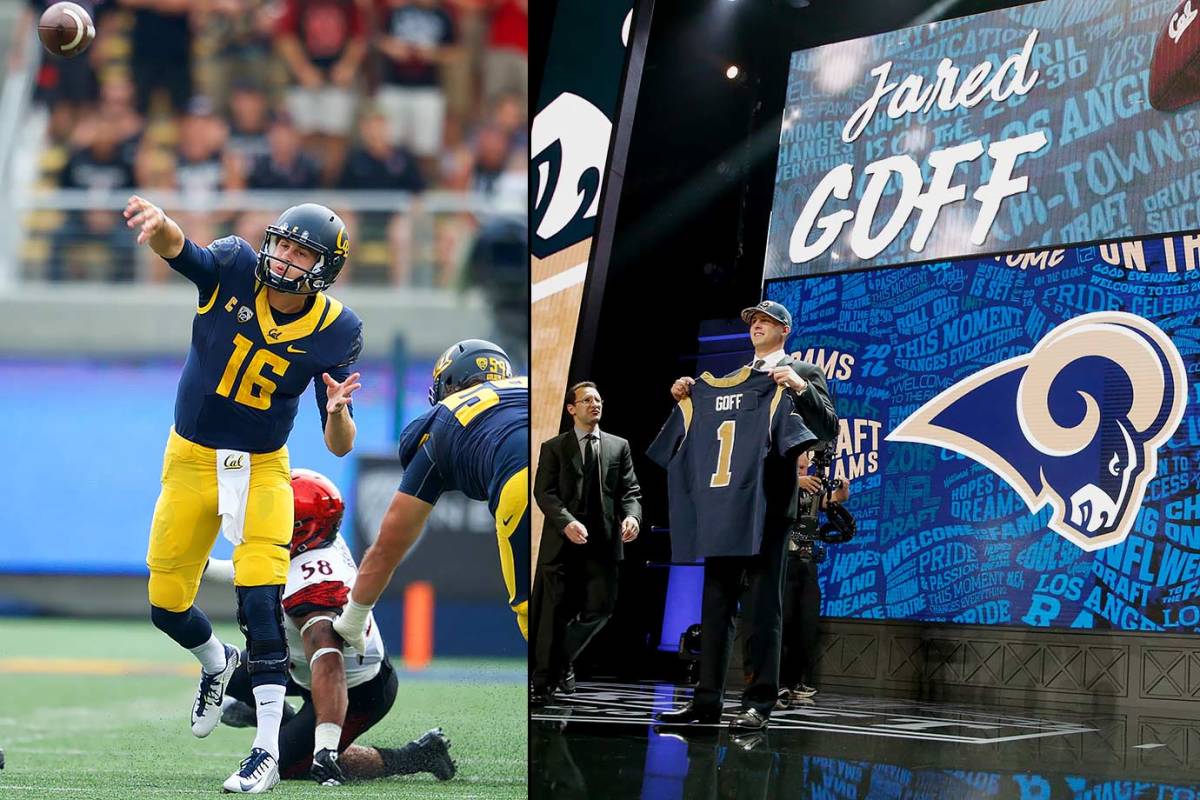
The first question is, how does Goff—who ran a “Bear-Raid” offense at Cal—fit into the Rams' power scheme with limited passing options? He'll have to adjust protections, which he hasn't really done before. It helps that the onus won't be on him to throw 50 times a game in a complex system, but this is a worrying pick given everything the Rams gave up to move to No. 1. Goff is good under pressure for the most part, and he's used to throwing to iffy receivers, but systemically, it could be argued that Carson Wentz, who ran a more diverse power-based offense at North Dakota State, would have been the better fit here.
2. PHILADELPHIA EAGLES: Carson Wentz, QB, North Dakota State — GRADE: A
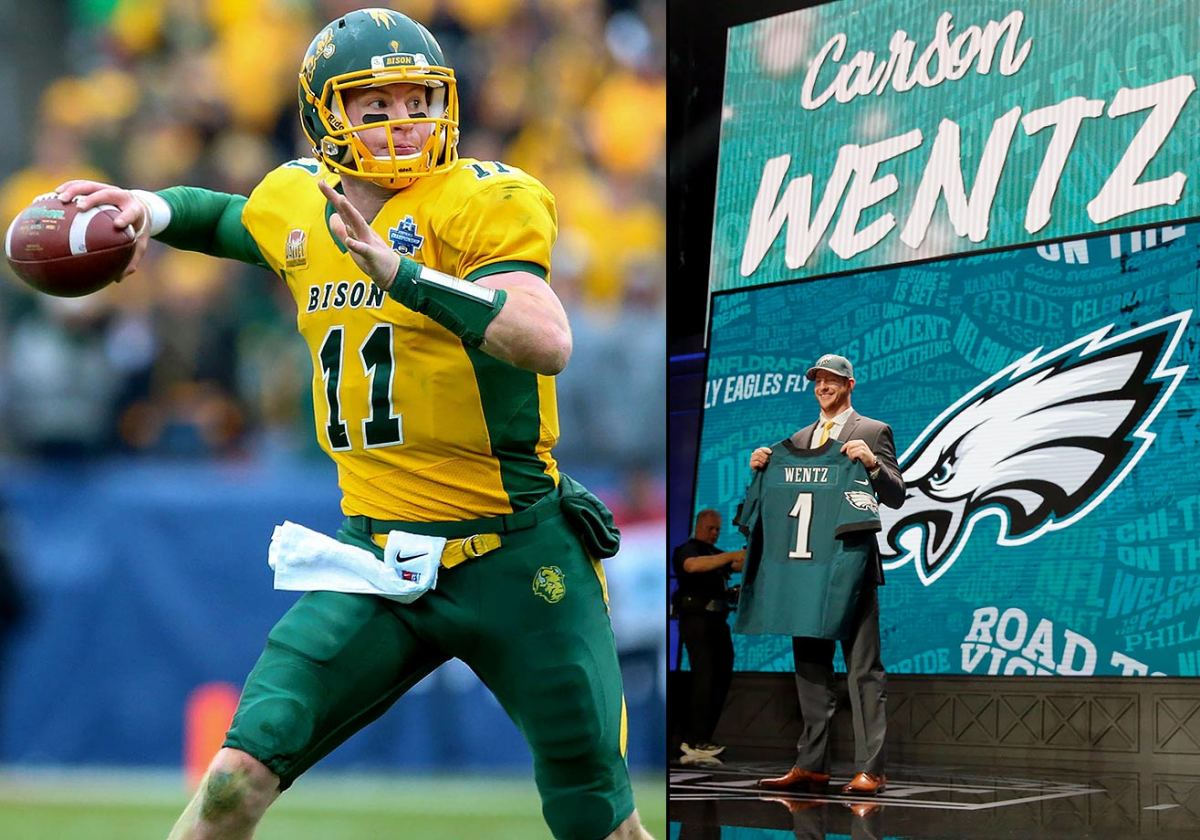
Don’t debit Wentz because he played in the Missouri Valley Football Conference—he’s more NFL-ready than you may think. He has great mobility, the size to run QB power like Cam Newton and a full read palette that belies his small-school history. The Eagles got the second quarterback in this draft class, but in the end, they may well have selected the better one overall. Think Ben Roethlisberger as a long-term comparison.
3. SAN DIEGO CHARGERS: Joey Bosa, DE, Ohio State — GRADE: D
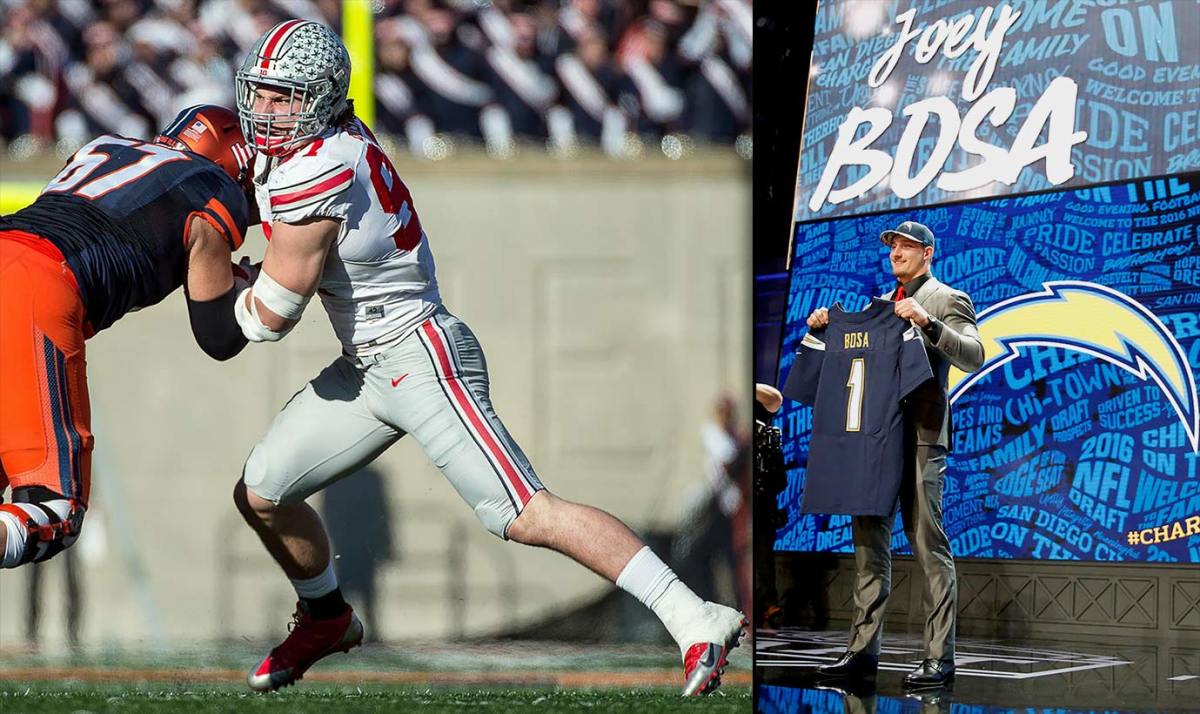
This is a curious pick, when you consider that Bosa may not be the best defensive lineman in this draft class, and he's a tweener for San Diego's 3–4 scheme. If he keeps his weight down and plays OLB, he's got average speed and will have to max out his technique. If he bulks up as a 3–4 end, that's a separate issue when it comes to his speed. The Chargers are clearly betting on Bosa's football intellect, but they may bump up against his low ceiling sooner rather than later. Think of Chris Long as a comparison—a really good run defender whose sack totals will be relatively low. DeForest Buckner does most of what the Chargers want better than Bosa does.
4. DALLAS COWBOYS: Ezekiel Elliott, RB, Ohio State — GRADE: A
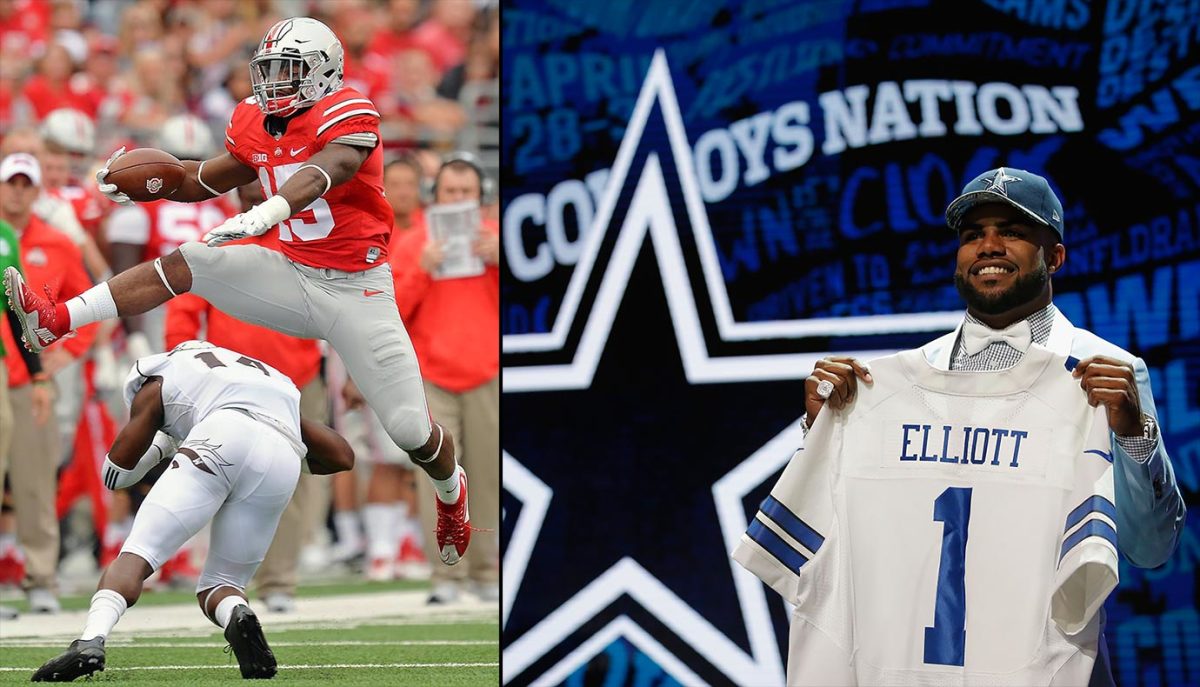
This is a natural pick for the Cowboys, because they have the best run-blocking line in the league, but they haven’t been able to replace DeMarco Murray’s production. Elliott is comparable to LaDainian Tomlinson because he runs so well between the tackles, he’s shifty outside and he’s a tremendous blocker. Like Tomlinson did after his stint at TCU, Elliott can also blossom into a top-notch receiver. Not that he needs huge gaps to make things happen, but he’s going to get them running behind this line, and we could be talking about a future rushing champ here. Elliott will define the Cowboys’ offense through the end of the Romo era and beyond.
5. JACKSONVILLE JAGUARS: Jalen Ramsey, DB, Florida State — GRADE: A+
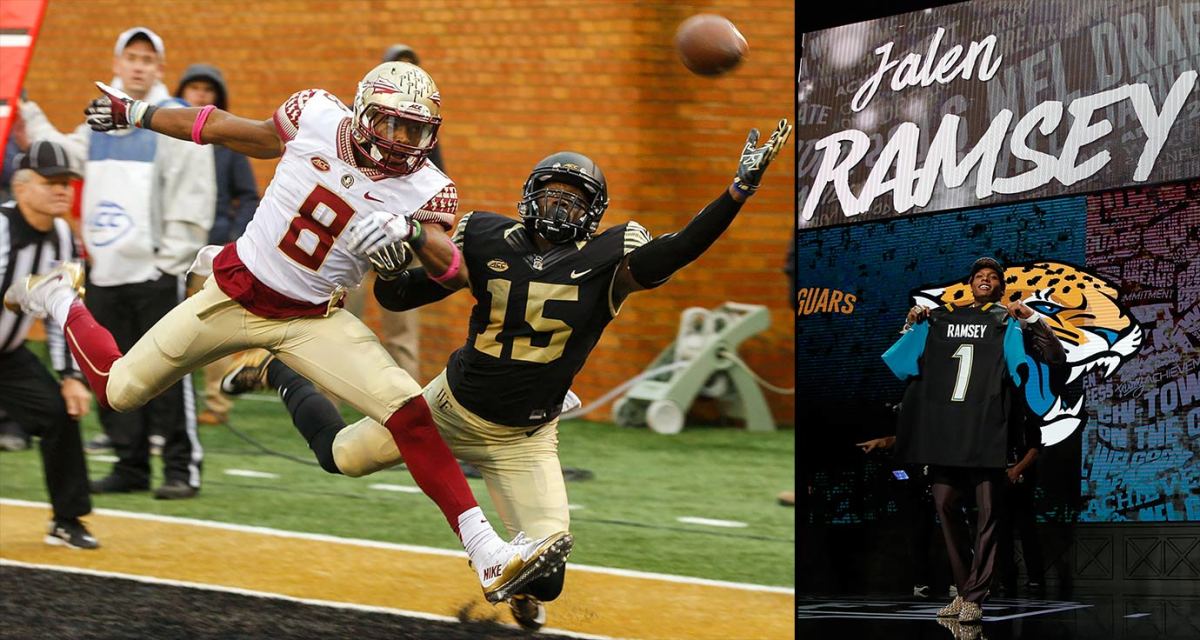
Ramsey is the top player in this year's SI 50, and Jags head coach Gus Bradley must be a bit gobsmacked by his own good luck here. What makes Ramsey special is that he's truly scheme-transcendent at multiple positions—cornerback, safety, and slot defender—and he'll be a force multiplier for Jacksonville's defense from the start. Jacksonville would be smart to start him off as a safety and nickel slot defender. That way, the Jags can take a year developing his CB skills and awaiting his development into the next Charles Woodson. This is a huge addition to an improving defense.
6. BALTIMORE RAVENS: Ronnie Stanley, OT, Notre Dame — GRADE: B
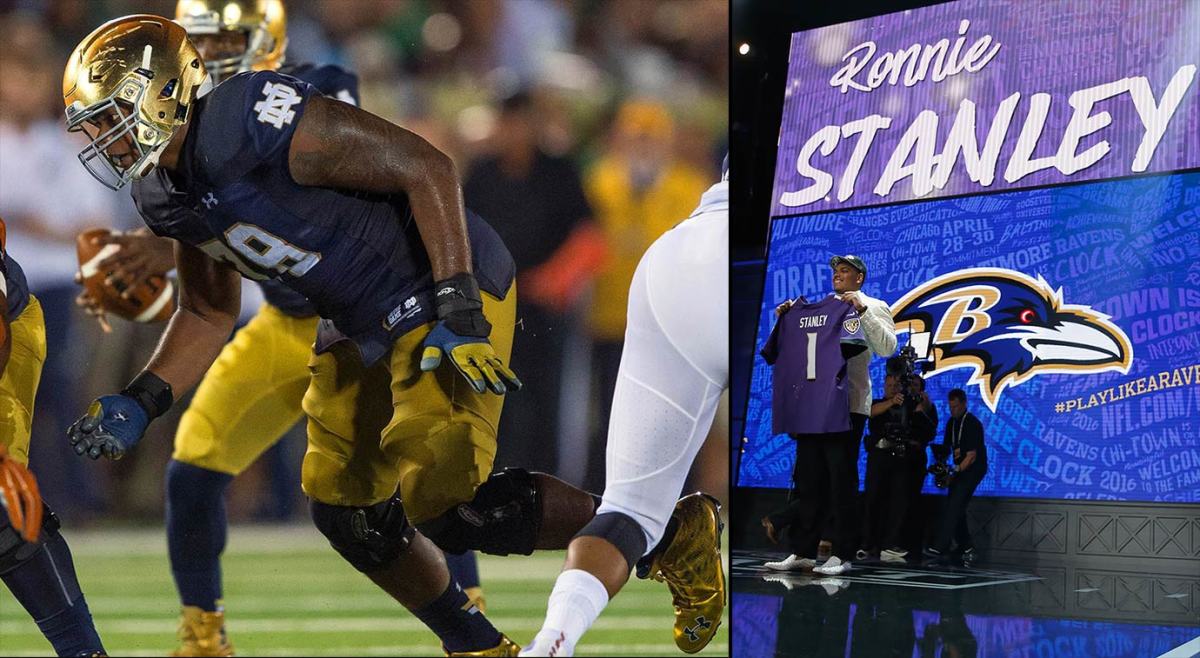
Stanley may be the best pass-blocking tackle in this draft class, though his run-blocking leaves something to be desired. While Laremy Tunsil is the better player, Stanley has more upside. In any case, Stanley can kick over to the right side in the short term and sub in seamlessly for Eugene Monroe if Monroe gets hurt or is a cap casualty. Stanley has the look of a multi-Pro Bowl left tackle if he can get his upper-body strength together and better seal defenders to the edge in running plays.
7. SAN FRANCISCO 49ERS: DeForest Buckner, DE, Oregon — GRADE: A
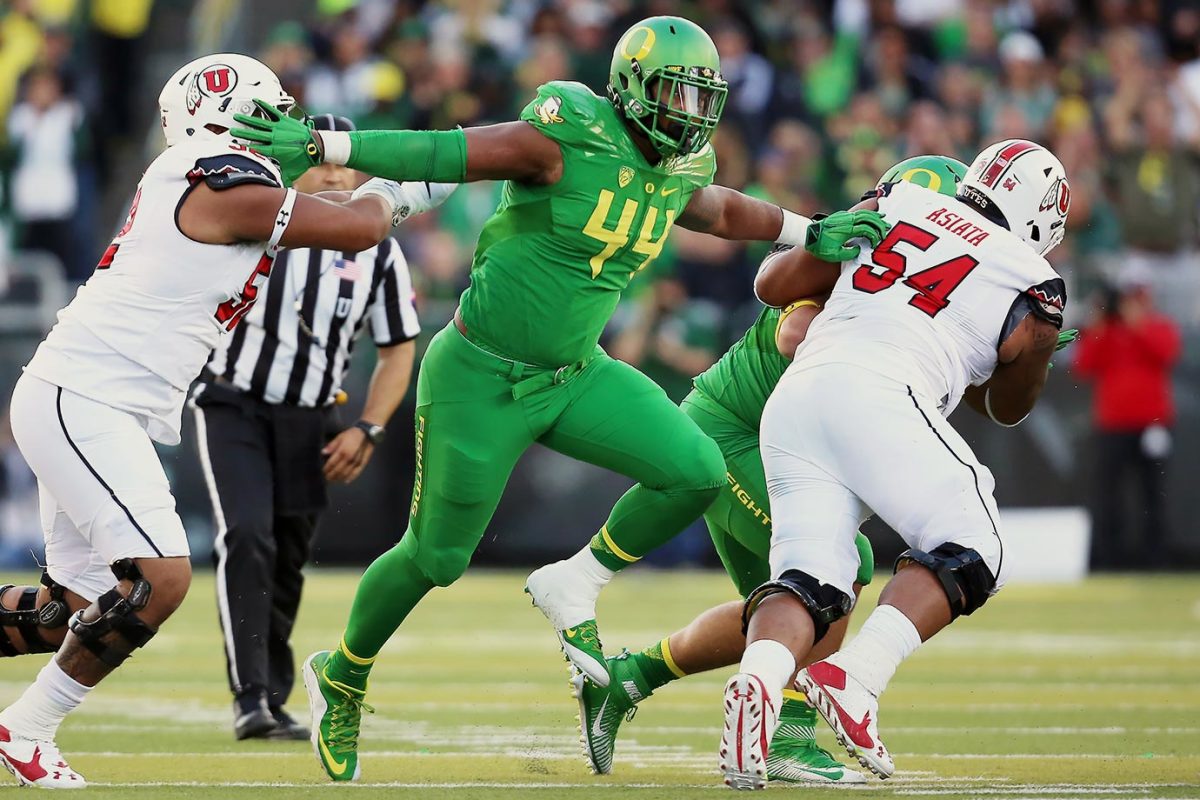
The 49ers take who the Chargers should have taken with the third overall pick. Unlike Joey Bosa, Buckner actually is the best defensive lineman in this class, with the ability to dominate everywhere from head-over nose tackle to wide-nine defensive end. He is not a carbon copy of Arik Armstead, the former Oregon teammate the 49ers took in the first round last year—Armstead is half the player Buckner is right now. Buckner looks like a faster, more flexible Calais Campbell with all of Campbell's power. This is a major boost for a San Francisco defense that has lost more than its share of stars over the last two seasons.
8. TENNESSEE TITANS: Jack Conklin, OT, Michigan State — GRADE: B
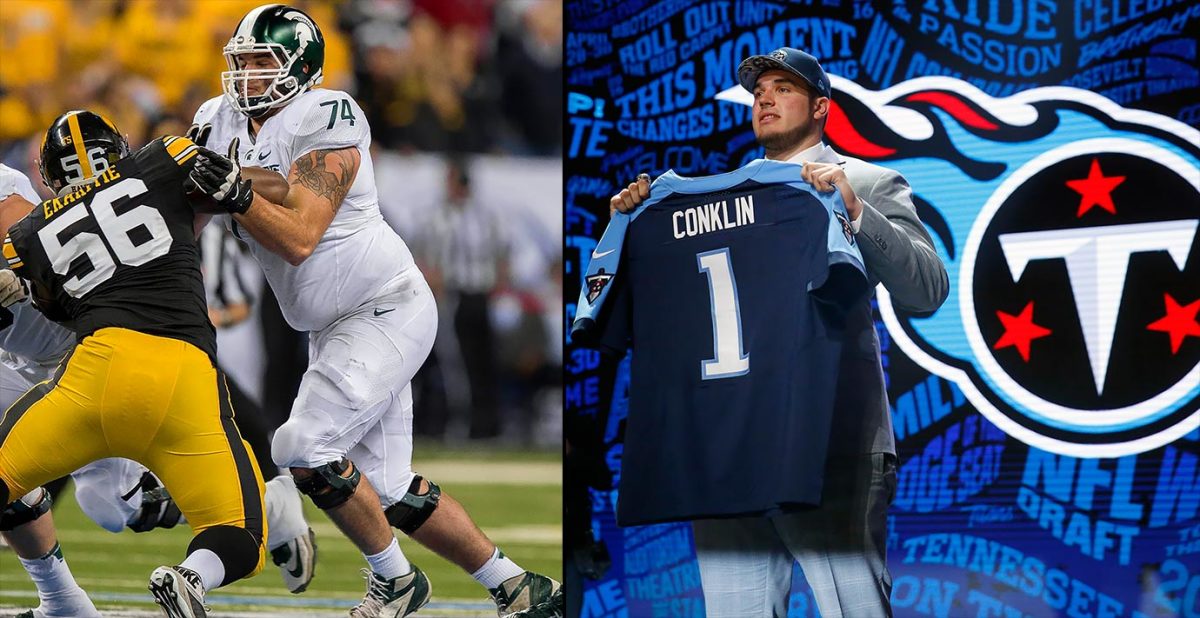
This is an amazing get for the Titans and new general manager Jon Robinson. They traded down from the No. 1 pick, got most of the Rams’ next two drafts and picked up the offensive lineman they wanted. Now, the question is whether Conklin stays on the left side—he's a tremendous run-blocker with limited pass-protection ability at this point. Conklin can be an elite blindside tackle in a power system over time, and he could also move inside to guard. He’s probably the most fundamentally sound blocker in this class, so the Titans are winning this draft already. Should Tunsil have been the pick instead? That question docks this pick a letter.
9. CHICAGO BEARS: Leonard Floyd, OLB, Georgia — GRADE: B-
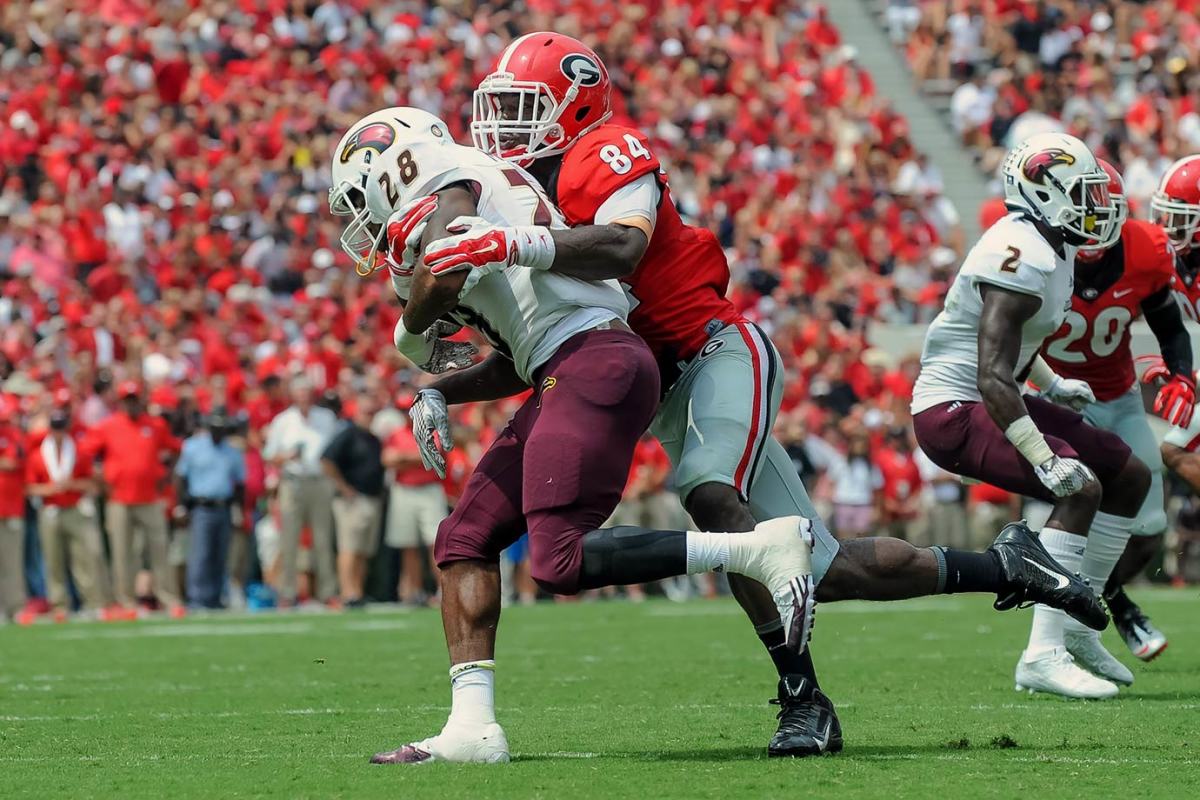
Floyd does fit the NFL's preference for rangy, big linebackers who can do a lot of things. At 6' 6" and 244 pounds, Floyd can careen off the edge as adeptly as he drops into coverage. However, he'll have to be used a certain way, because he lacks the tackling strength to take on running backs consistently. Chicago signed Danny Trevathan and Jerrell Freeman in the off-season to reinforce their weak linebacker corps, so defensive coordinator Vic Fangio will have the option to move Floyd around. The low grade has more to do with Floyd's slight build—he could be Barkevious Mingo or Bruce Irvin just as easily as he could be an elite pass-rusher at the next level.
10. NEW YORK GIANTS: Eli Apple, CB, Ohio State — GRADE: B
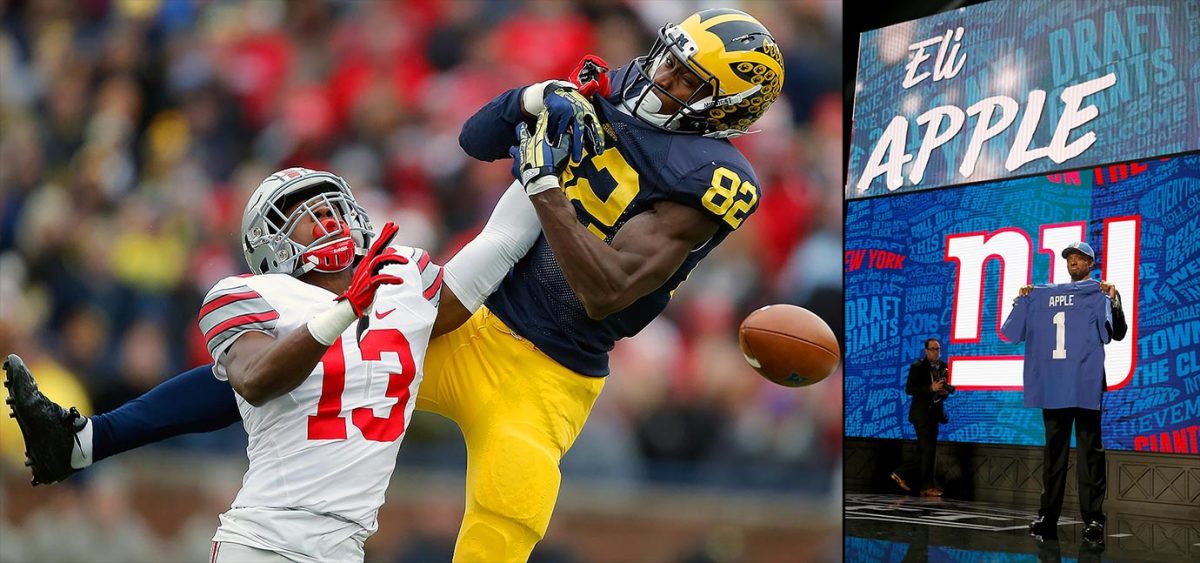
Though they signed Janoris Jenkins in the off-season, there was still a clear need for more help at cornerback for the G-Men. Apple fits as a natural press-man defender with tremendous aggressiveness and the ability to redirect receivers where he wants them to go. One could question whether Mackensie Alexander or Vernon Hargreaves is the better talent pick here, but the Giants want cornerbacks who are aggressive to the point of failure, and Apple fits the bill. He’ll have to watch the penalties, to be sure.
11. TAMPA BAY BUCCANEERS: Vernon Hargreaves, CB, Florida — GRADE: A-
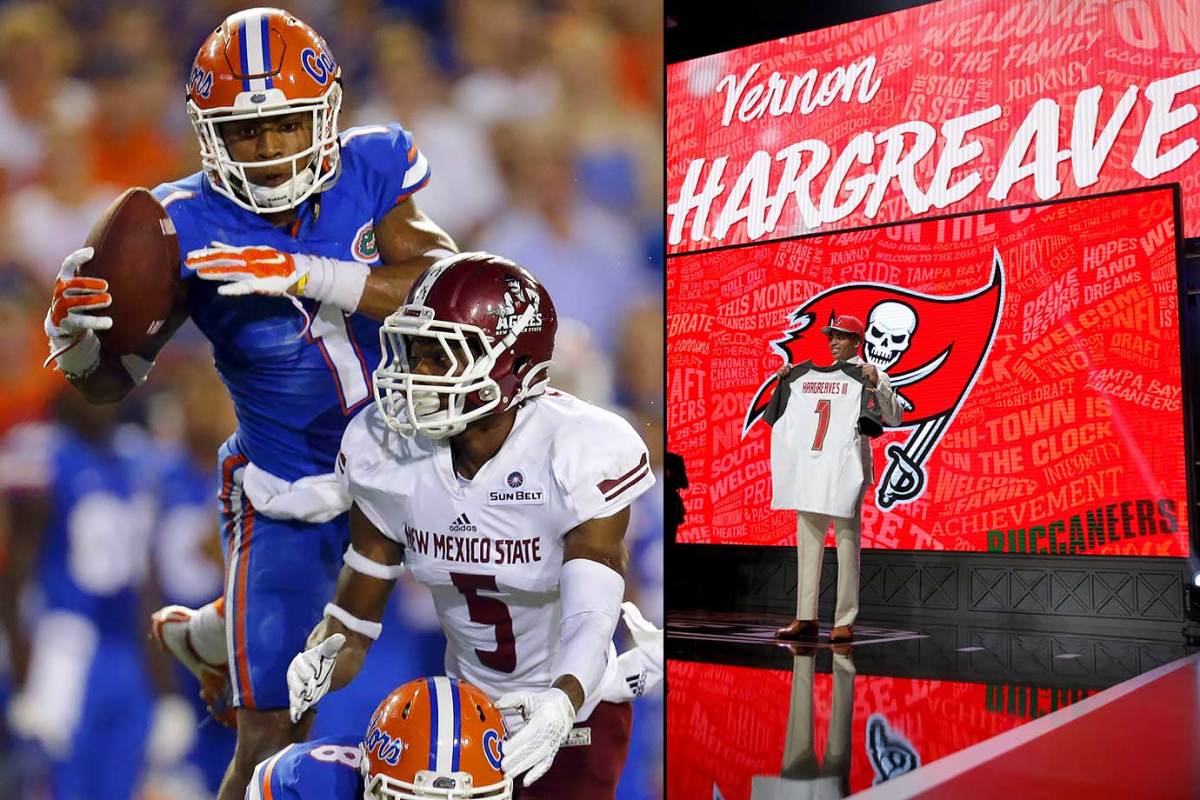
Many mocks had Hargreaves to the Bucs, given their issues at cornerback in 2015, and full marks to them for giving the Bears their No. 9 pick and still getting their man. Hargreaves is an aggressive, athletic player with a no-fear attitude in run support. He's also one of the best pattern-readers in this class, which will help him against better receivers. On the downside, he does get beaten deep, and there are concerns about his height (5' 10"). But he's matched up against the best the SEC has to offer, and he has the potential to do the same in the NFL.
12. NEW ORLEANS SAINTS: Sheldon Rankins, DT, Louisville — GRADE: A+
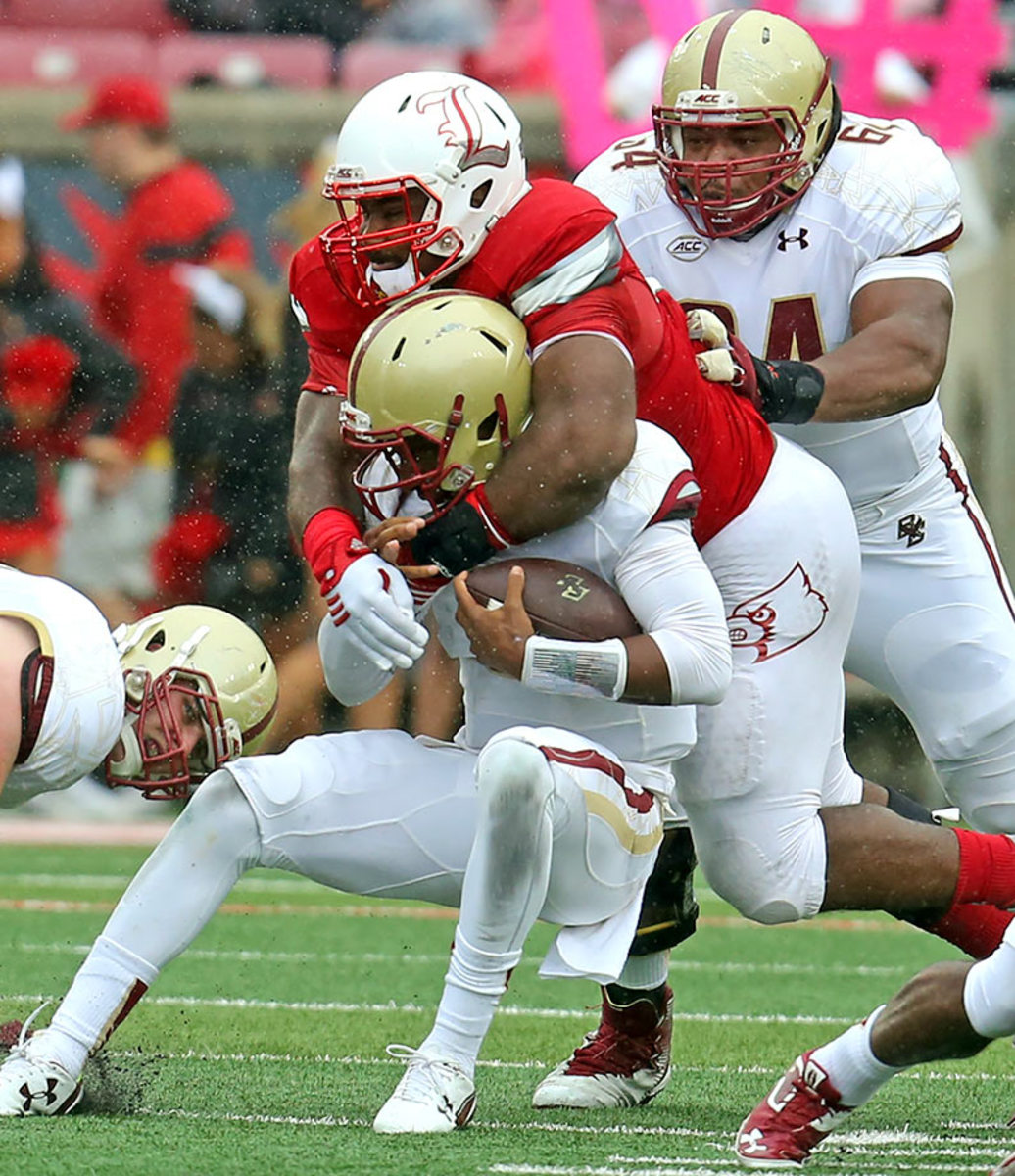
The Saints need all kinds of help on their defensive line, and Rankins is an absolute monster in the Sheldon Richardson mold. Rankins can play head-over-nose, three-tech and five-tech. His short arms could affect his ability to hold blockers off, but he’s a high-motor guy who will be even better when he adds to his limited palette of hand moves. A huge coup for New Orleans.
13. MIAMI DOLPHINS: Laremy Tunsil, OT, Ole Miss — GRADE: A
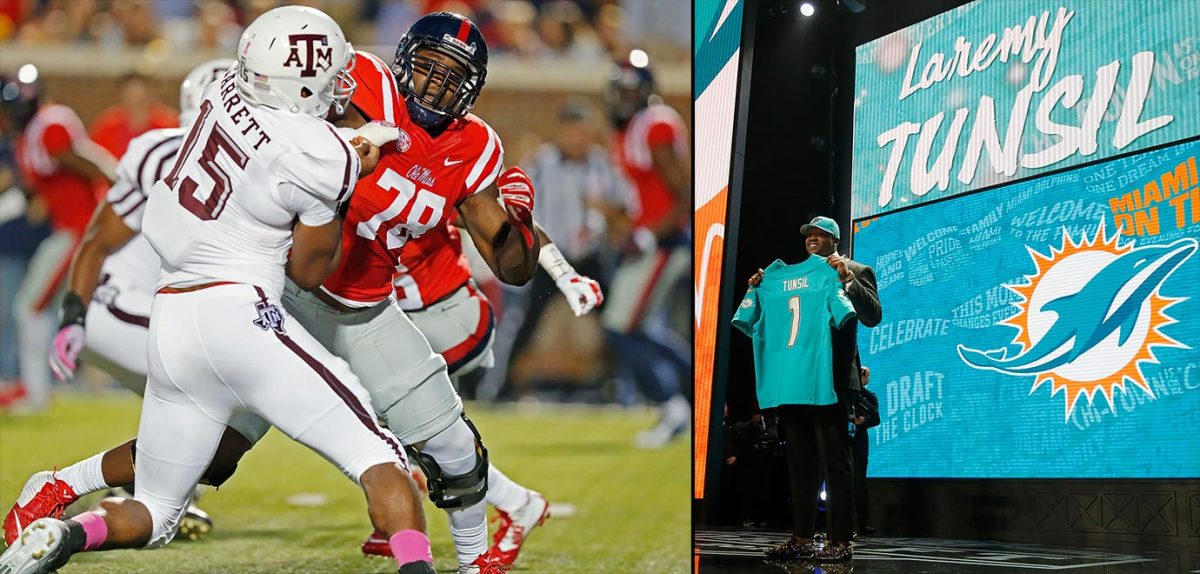
Tunsil's drop in the draft for an old video of him goofing around with a gas mask and a smokable substance aside, the Dolphins may have picked up the steal of the draft. Tunsil had the cleanest tape of any prospect in this draft. From run-blocking to pass protection to picking up stunts and zone pressures, there's nobody better in 2016, and few better in recent years. As long as that video isn't indicative of any further issues, Tunsil is a huge addition to an offense in need of blocking help. He gave up no sacks and no quarterback hits in 2015 for Ole Miss. Tyron Smith is a good comparison.
14. OAKLAND RAIDERS: Karl Joseph, S, West Virginia — GRADE: C
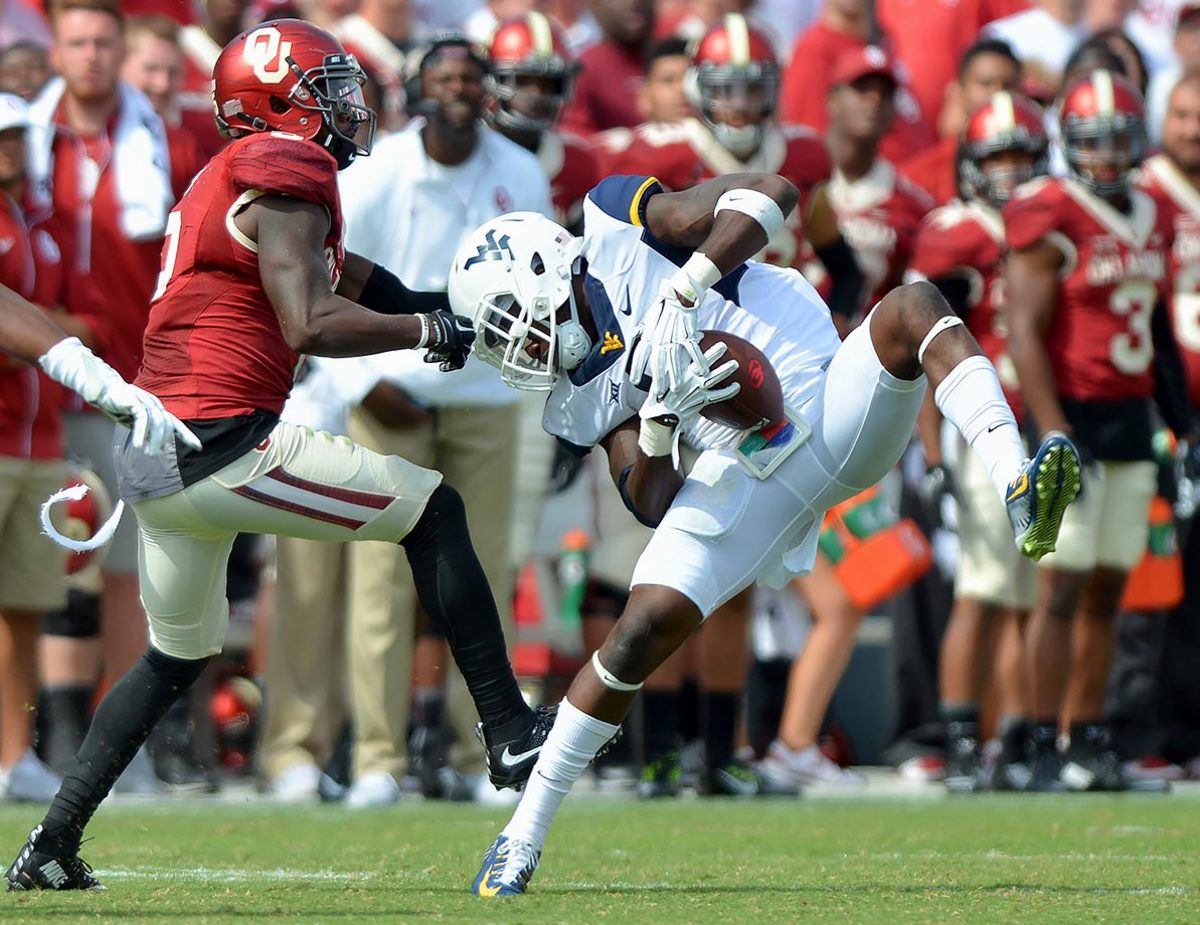
An interesting pick for a team in need of secondary help. Reggie McKenzie has done a lot to put the Raiders back on track, and Joseph is a big hitter with some coverage ability. He'll replace Charles Woodson, which is a major thing to do. But at 5' 10" and 205 pounds, he's a little light for the position at the NFL level. Bob Sanders will be the ideal, but Sanders was an outlier, and he was also hurt a lot. Size debits combined with a physical style seems to be a recipe for danger, but Joseph is a true competitor.
15. CLEVELAND BROWNS: Corey Coleman, WR, Baylor — GRADE: B
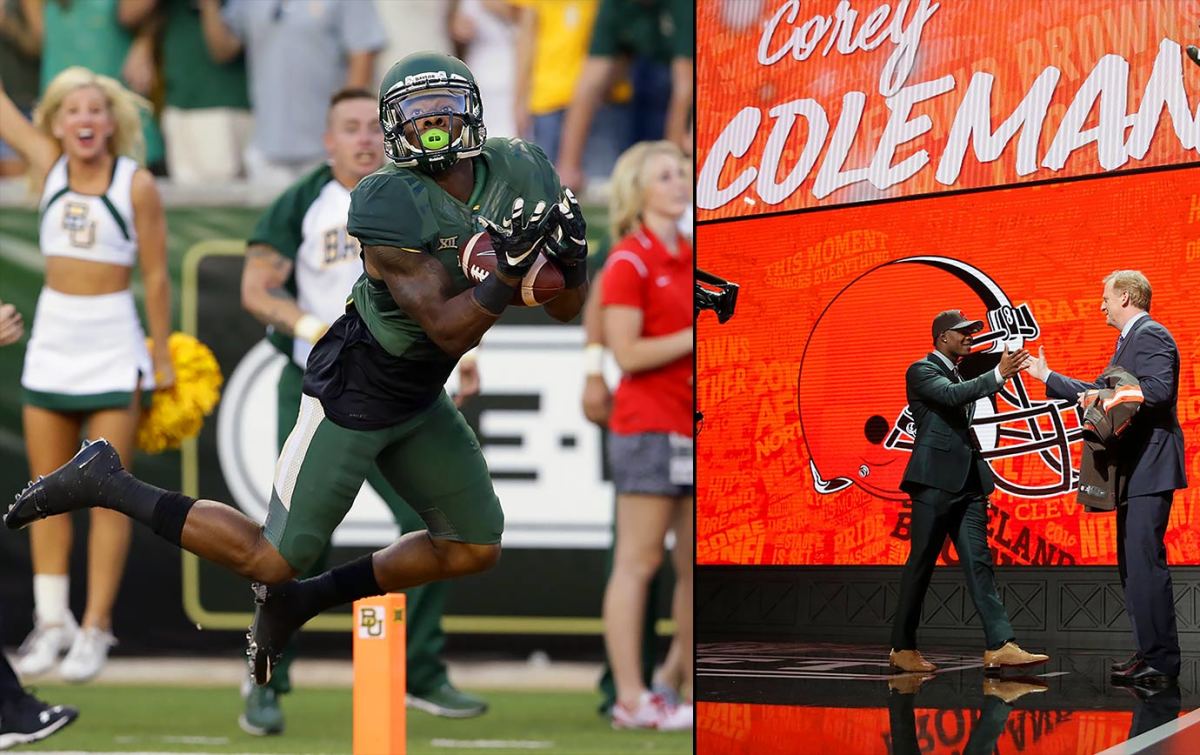
Coleman is unquestionably the most explosive receiver in this class, with the ability to flat-out smoke anyone covering him. In addition, and surprisingly enough for a pure spread offense like Baylor's, he does have a natural sense of route development. Most likely, Cleveland will have to work with what he can do in the short term, while teaching him the full route tree over time. Is he a No. 1 receiver in the Antonio Brown mold? That's a stretch, and it's hard to rationalize this pick with Josh Doctson still on the board. But this guy can really fly.
16. DETROIT LIONS: Taylor Decker, OT, Ohio State — GRADE: B-
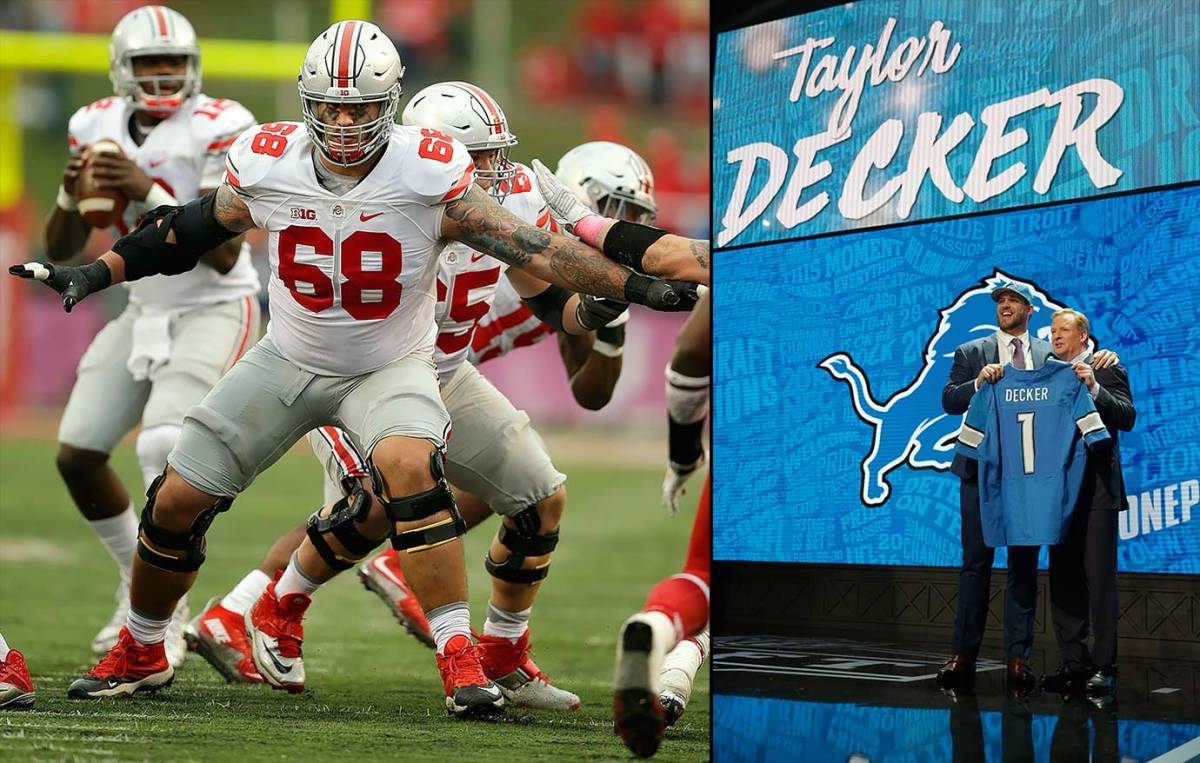
A safe pick for a team in desperate need of better pass protection. Matthew Stafford has been sacked a ton in the last two seasons, and Riley Reiff hasn't shown the ability to hold up on the blind side. Decker will have to keep his body lean low to avoid getting overpowered, but he is one of the better run blockers in this class. Some may question his potential as a left tackle in the long term, and if he can't hang on that side, this could prove to be a major mistake.
17. ATLANTA FALCONS: Keanu Neal, S, Florida — GRADE: C
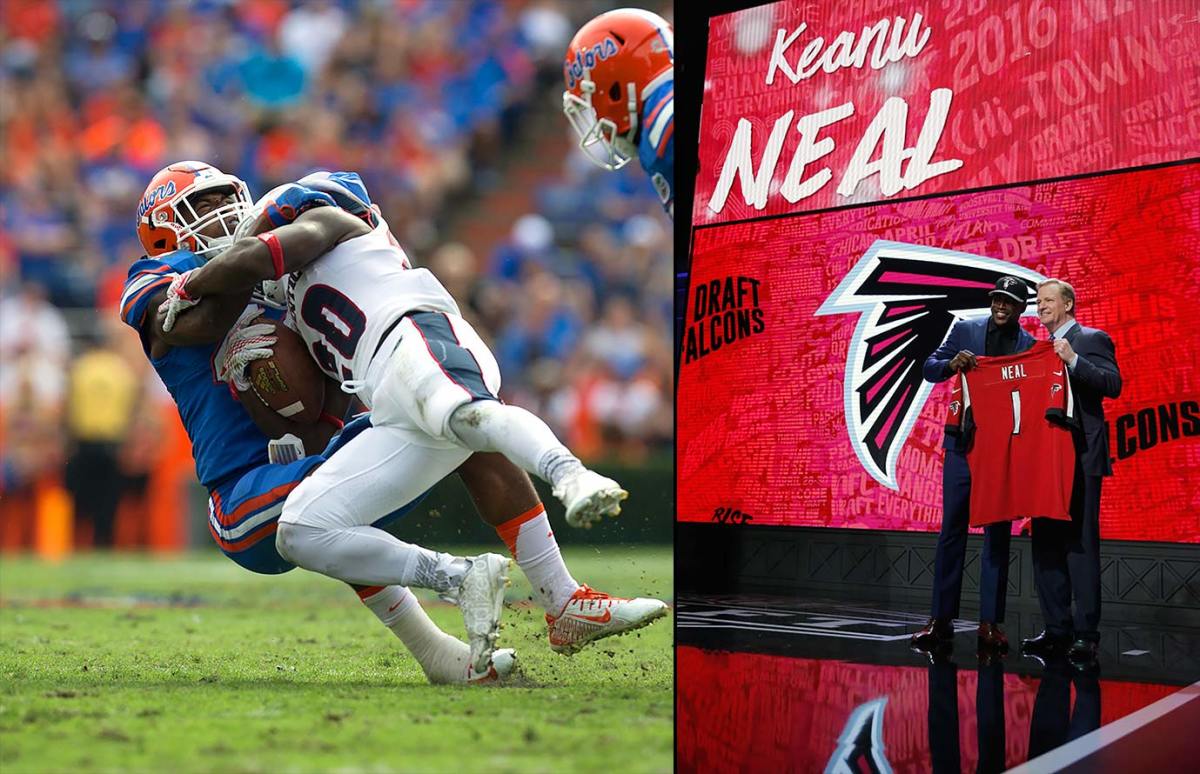
Falcons coach Dan Quinn was in Seattle for the rise of Kam Chancellor, and Neal fits a similar profile. At 6' 0" and 211 pounds, he's a feared hitter who needs development in coverage. Quinn saw Chancellor become a great cover guy over time, but spending the No. 17 pick on a prospect who's best in the box and limited everywhere else is a questionable strategy at best. I'd be surprised if half the teams in the league didn't have him in the second round.
18. INDIANAPOLIS COLTS: Ryan Kelly, C, Alabama — Grade: B
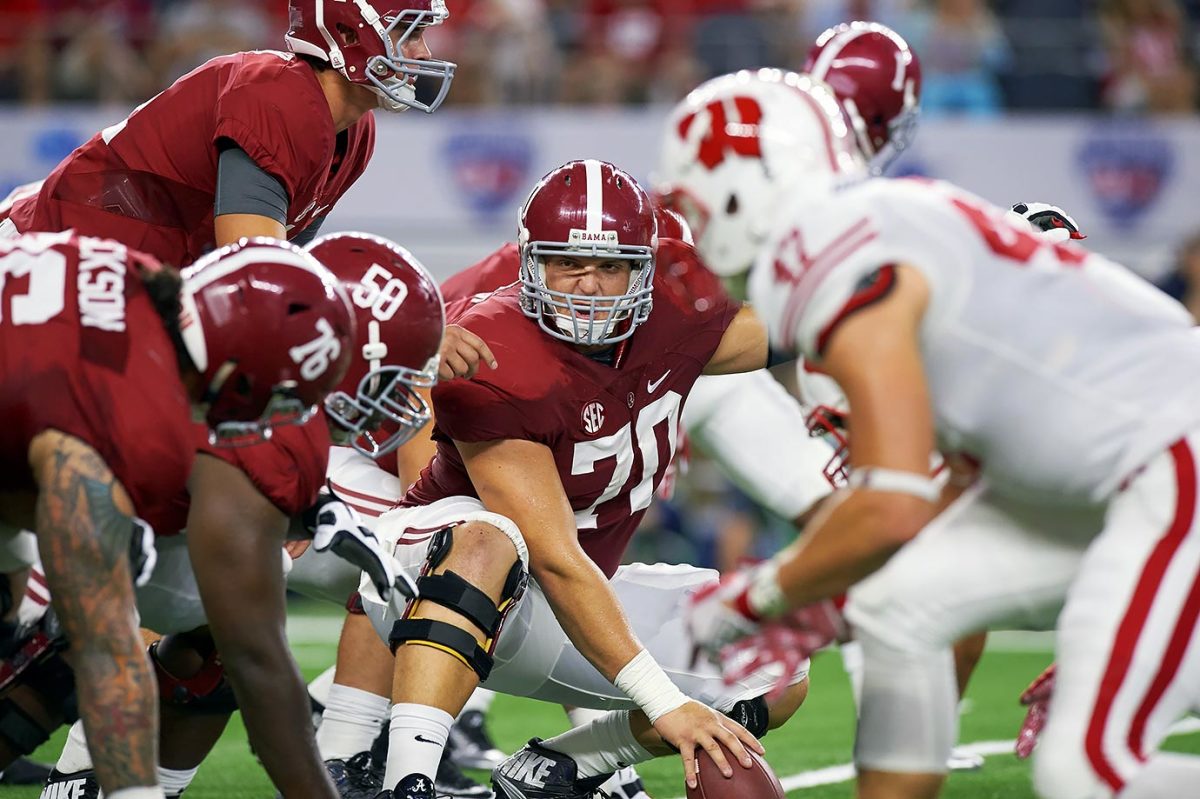
A very safe pick for general manager Ryan Grigson, who has made his share of head-scratchers in the last few years. Andrew Luck has been getting killed with pressure up the middle, and Kelly can come right in and make a big difference. He's a road-grader at the point of attack, but he can also move to the second level and dominate when asked to seal-block linebackers and safeties. Kelly becomes the first solid center for the franchise since Jeff Saturday.
19. BUFFALO BILLS: Shaq Lawson, DE, Clemson — GRADE: B
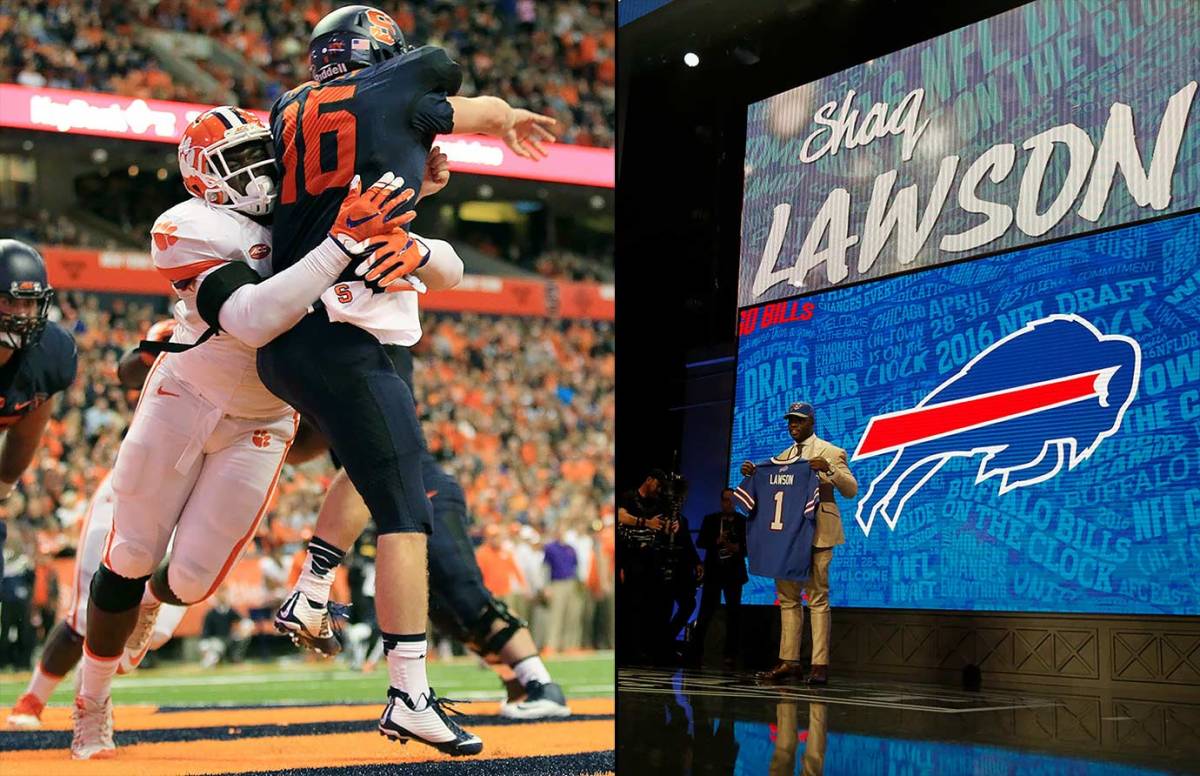
Don't call Lawson a one-year wonder—it was tough for him to find starting time earlier in his career along Clemson's deep line. He amassed 35 solo tackles, 12.5 sacks and 24.5 tackles for loss in 2015, and he combined the edge speed to beat tackles outside with the power to move guards inside. He's not the same type of player as Mario Williams, but he may put up similar pressure numbers over time. He needs a little technique work, but where better to hone that than within a Rex Ryan defense?
20. NEW YORK JETS: Darron Lee, LB, Ohio State — GRADE: B+
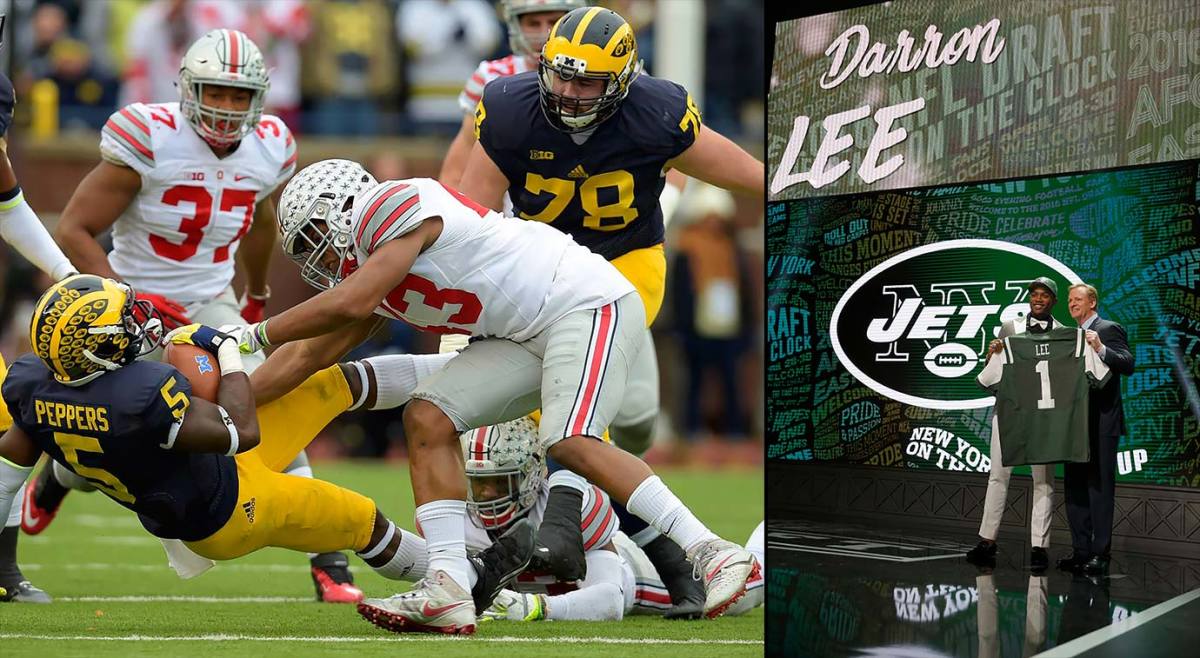
The Jets need more players with real movement skills, and with Myles Jack's medicals pulling him down the board, Lee may very well be the next-best option. He won't impress anyone with his size (6' 1", 232 pounds), but remember that Jets coach Todd Bowles was in Arizona when Karlos Dansby and Daryl Washington were redefining what mobile linebackers could do. Now, Bowles has his own cover linebacker who can tackle pretty well, rush a bit and cover everything from curl-flat to seam routes. From that perspective, it's a good pick. Those who are unimpressed are just going to have to realize that the 230-pound linebacker is the wave of the future.
21. HOUSTON TEXANS: Will Fuller, WR, Notre Dame — GRADE: A-
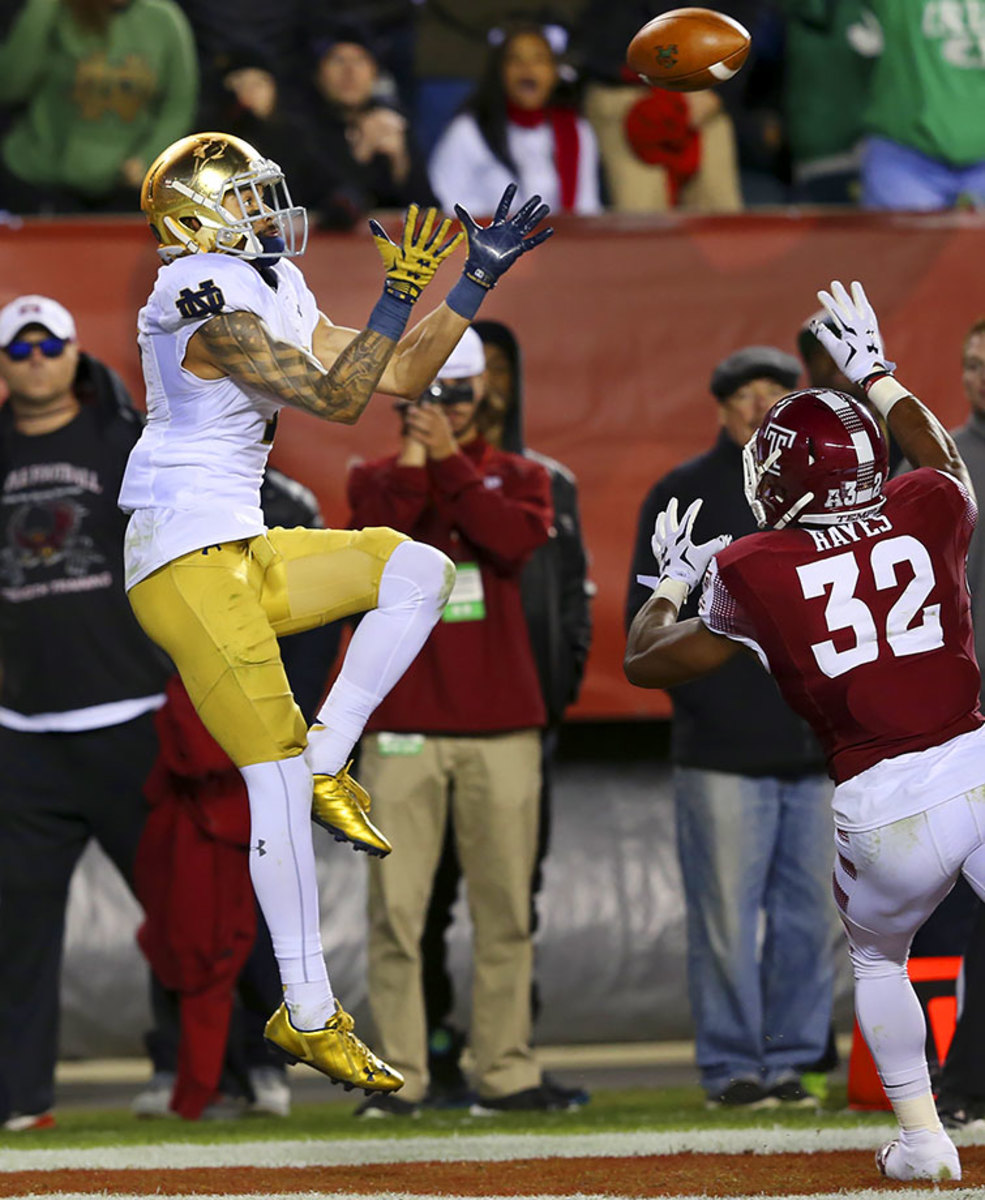
Adding Fuller to a receiver corps already blessed with DeAndre Hopkins is a force multiplier for the Houston offense. While Hopkins is the do-it-all guy, Fuller is a pure speed burner who will take the top off any coverage. He's not physically dominant, he'll drop passes and he needs work with the full route tree, but he's going to help this offense a ton. Factor in the free agent additions of Brock Osweiler and Lamar Miller, and Bill O'Brien has himself a pretty formidable offense all of a sudden.
22. WASHINGTON REDSKINS: Josh Doctson, WR, TCU — GRADE: A+
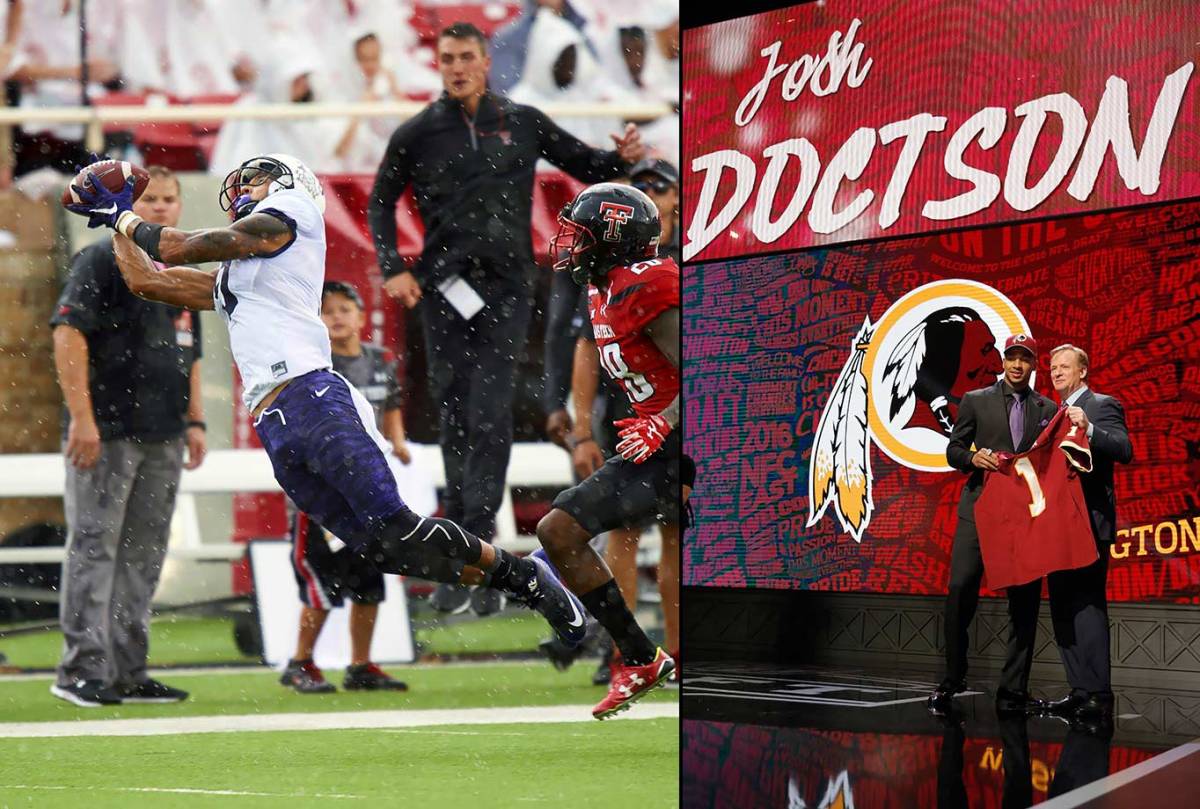
Doctson has been one of the most productive receivers in the nation in the last two seasons, and on tape his talent backs up all those numbers. Doctson is especially strong when asked to compete with cornerbacks and safeties on 50/50 balls, and he combines size, strength and speed to be one of the class's best talents at any position. Kirk Cousins just got himself a very good red-zone target and a perfect fit for Jay Gruden's West Coast offense.
23. MINNESOTA VIKINGS: Laquon Treadwell, WR, Ole Miss — GRADE: A
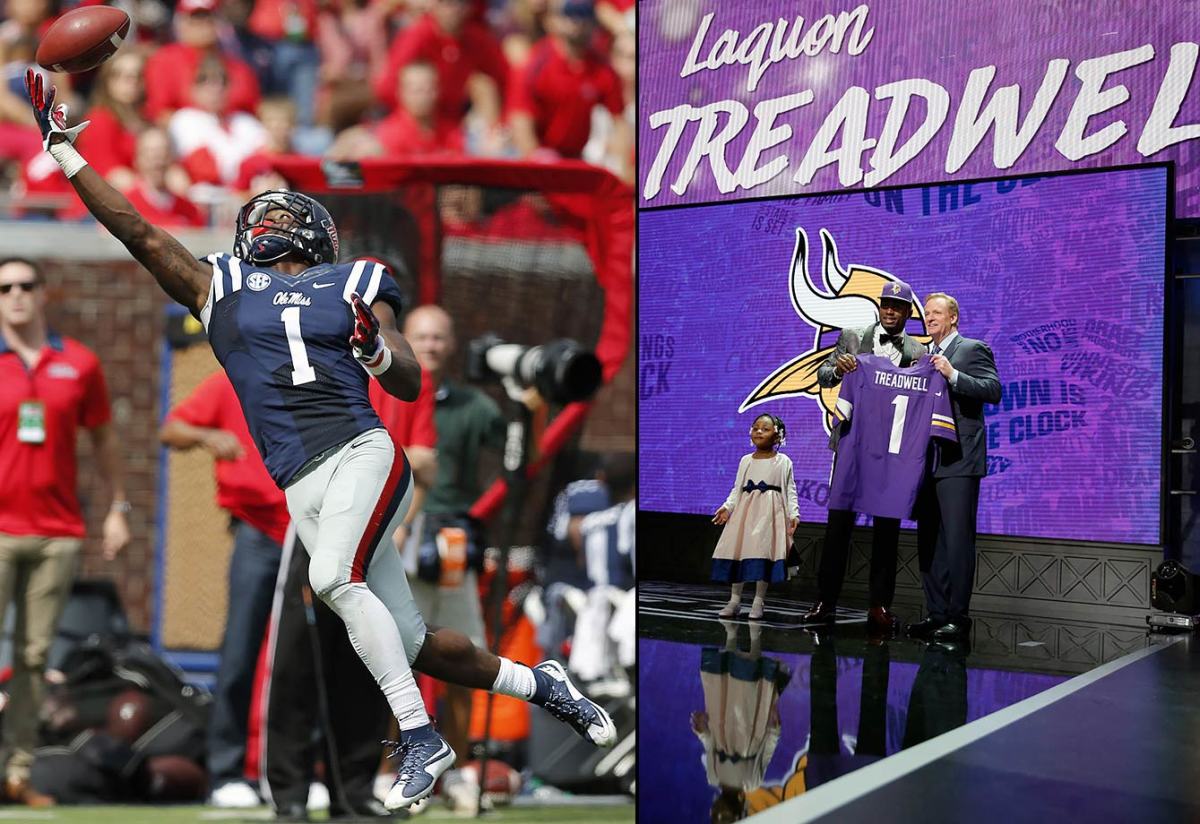
First of all, the talk about Treadwell's lack of speed is overblown—in Ole Miss's limited passing offense, he was often open and unseen. He's a tough, physical, consistent receiver who won't set any land speed records against deep safeties, but he has the skills to become Minnesota's top target. Yes, that's a low bar at this point, but GM Rick Spielman has to start somewhere. Add Treadwell to Stefon Diggs in the Vikings' receiver battery, and things are looking up for Teddy Bridgewater.
24. CINCINNATI BENGALS: William Jackson III, CB, Houston — GRADE: B
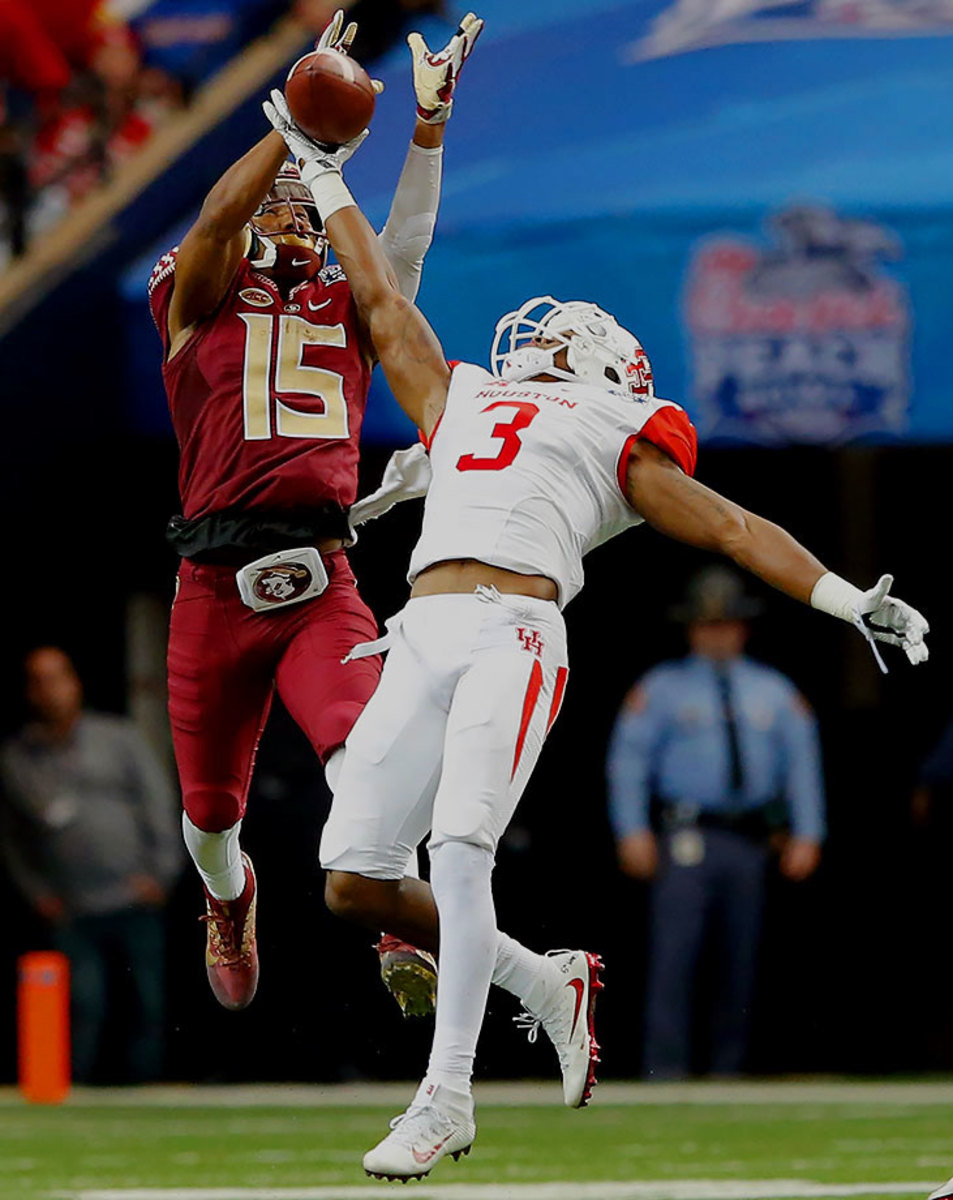
With most of the top receivers off the board, the Bengals turn to another need and draft Jackson, a natural press boundary cornerback with the tools and skills to stand up to the fastest and most physical receivers in the league over time. Last season, he put up 34 solo tackles, five interceptions (two returned for touchdowns) and 23 pass deflections to lead the nation in that category. He's a do-it-all player at a key position, though he'll have to get more efficient with his feet to avoid getting turned completely around by more savvy NFL receivers.
25. PITTSBURGH STEELERS: Artie Burns, CB, Miami — GRADE: C
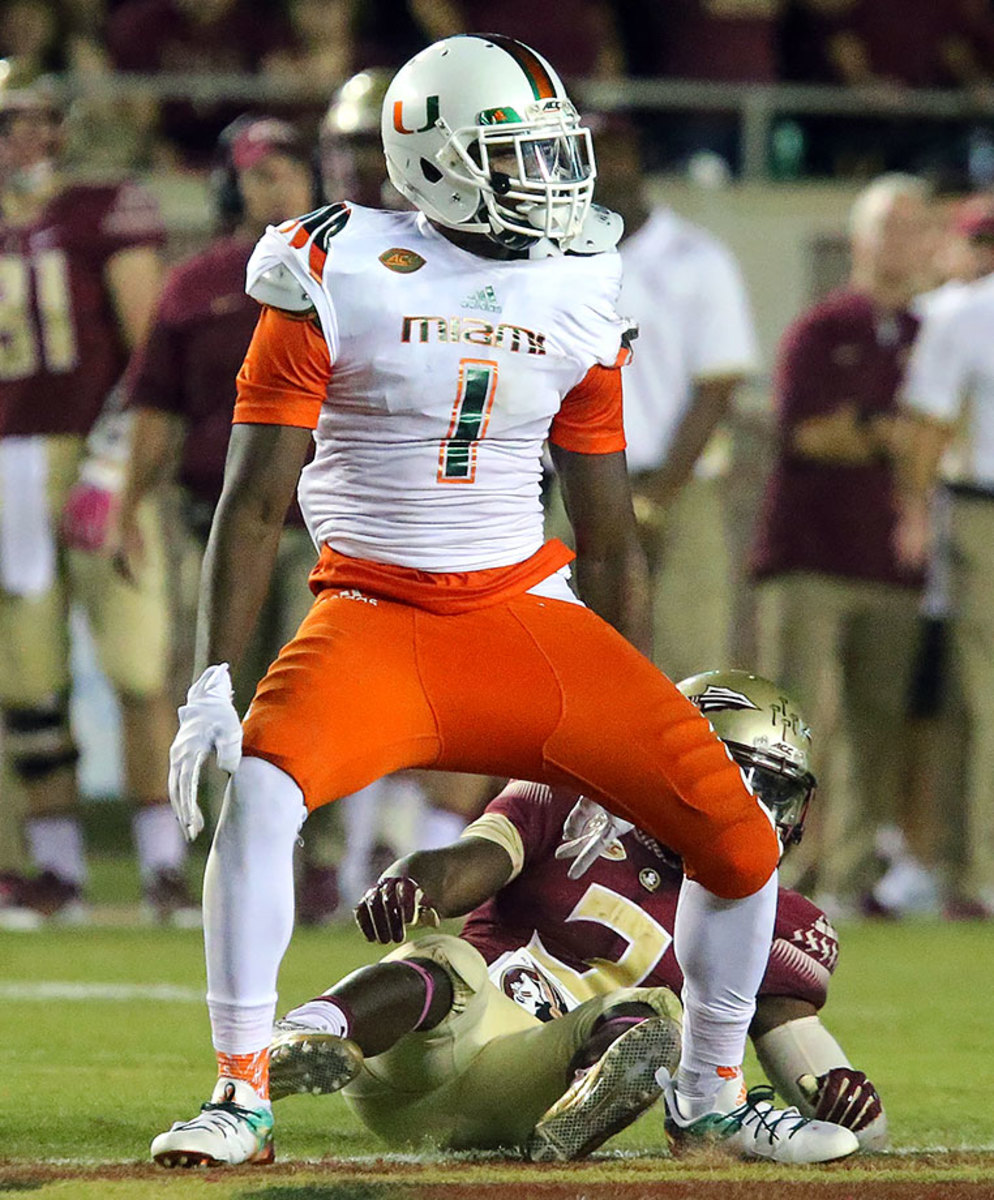
Steelers general manager Kevin Colbert has a history of slightly overdrafting defensive players from a value perspective, and Burns fits that category. He's a ridiculous athlete who has overcome a difficult past, but he's going to need time to deal with the complexities of NFL route concepts. This is a person you want to root for, and in time, it's a player who will start and succeed. It's just tough to pick a developmental guy when your team needs cornerback help right now.
26. DENVER BRONCOS: Paxton Lynch, QB, Memphis — GRADE: B+
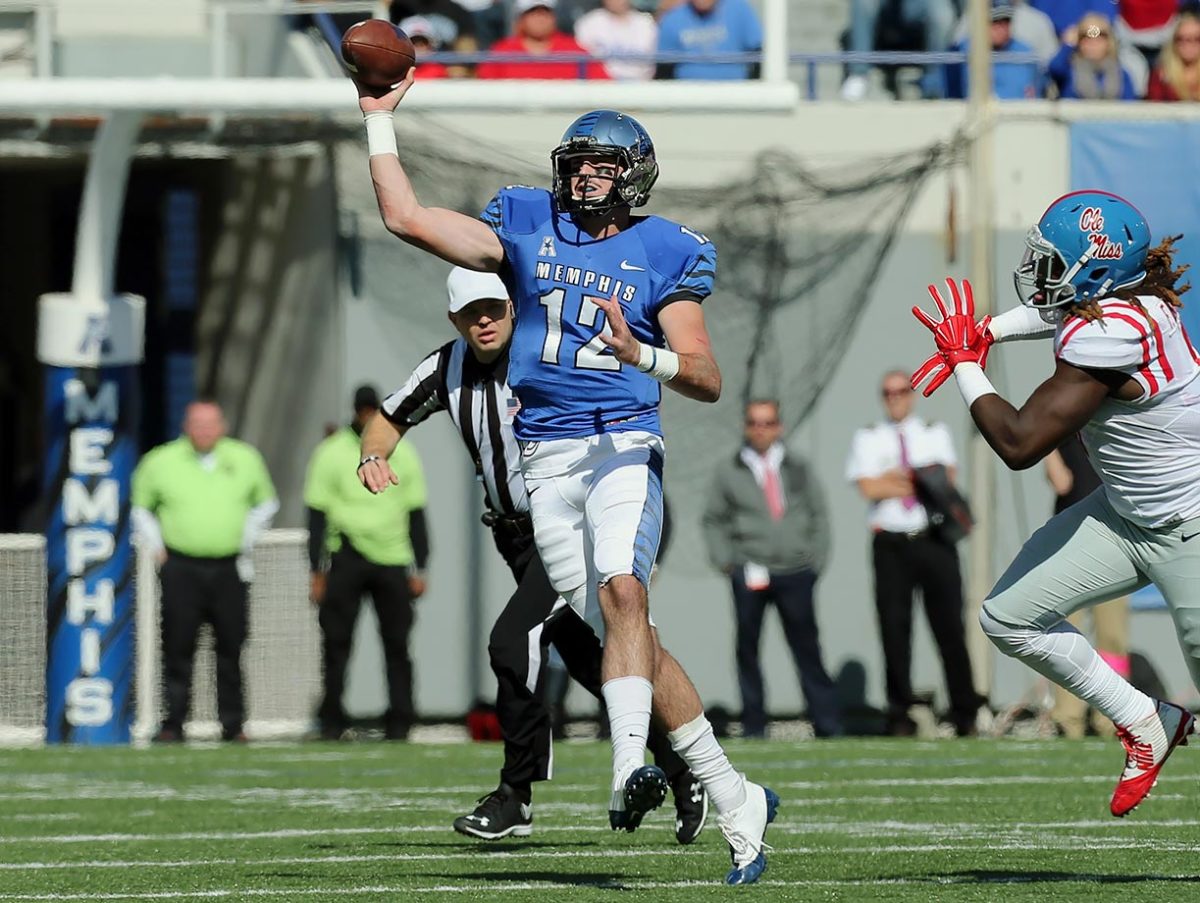
After losing Brock Osweiler to the Texans in free agency, the Broncos traded up with the Seahawks to take the most Osweiler-y quarterback in this draft class. Lynch stands 6' 7" and weighs 235 pounds, but he's very mobile, and his familiarity with boot action concepts makes him a perfect fit for what Gary Kubiak wants to do. Lynch may need a year or so to learn the complexities of the NFL game, but he might be put on an accelerated track with a somewhat simplified version of the Broncos' scheme.
27. GREEN BAY PACKERS: Kenny Clark, DT, UCLA — GRADE: A
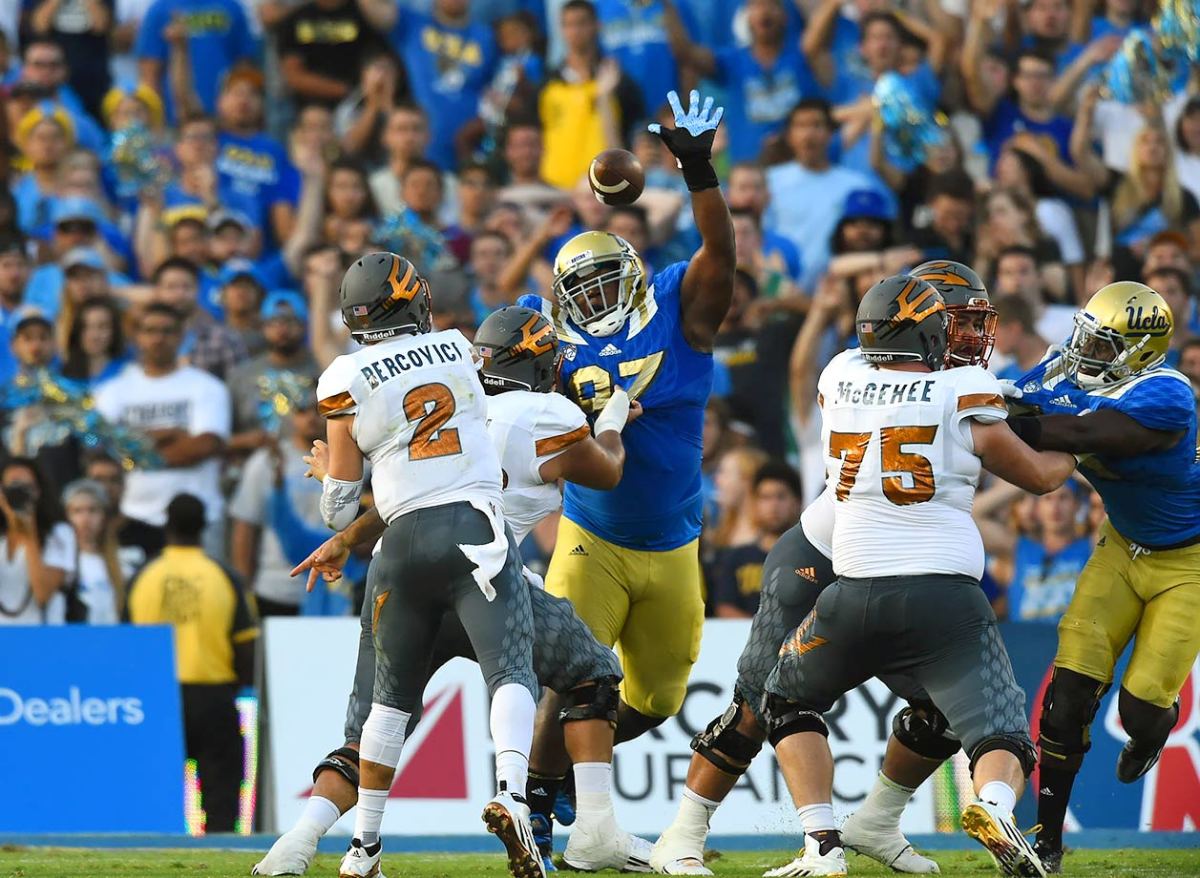
This isn't a sexy pick, given Clark's relative inability to rush the passer, but Clark is an instant wall for a defensive line in need of stability. At 6' 3" and 314 pounds, he can play 3-tech in a four-man front, or kick out to end in a 3–4 base. He's also a natural nose tackle with tremendous strength, and he's only 20 years old—he's got a lot of great football in front of him. He may be a two-down rotational guy to start his NFL career, with the opportunity to do a lot more.
28. SAN FRANCISCO 49ERS: Joshua Garnett, G, Stanford — GRADE: B
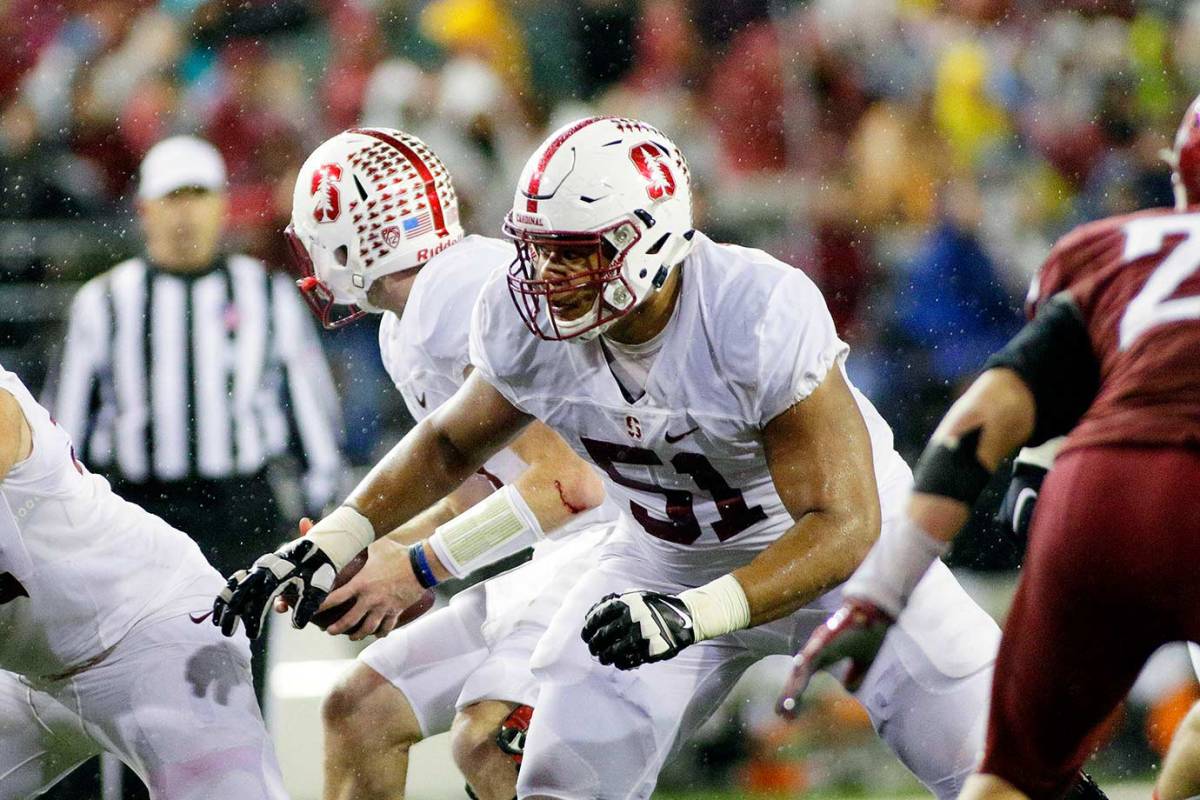
When the 49ers were crushing opponents with Jim Harbaugh's rushing attack, Mike Iupati was decimating opponents with his power at left guard. Garnett projects well as a similar player. He's a pure power guy who may need a bit of adjustment in Chip Kelly's zone scheme. Garnett has the talent to switch, and though it may take time for that to happen, he's going to be a special player over time. It's just a matter of scheme fit and how much you believe it's worth it to spend three picks to trade back into the first round for a guard.
29. ARIZONA CARDINALS: Robert Nkemdiche, DT, Ole Miss — GRADE: A-
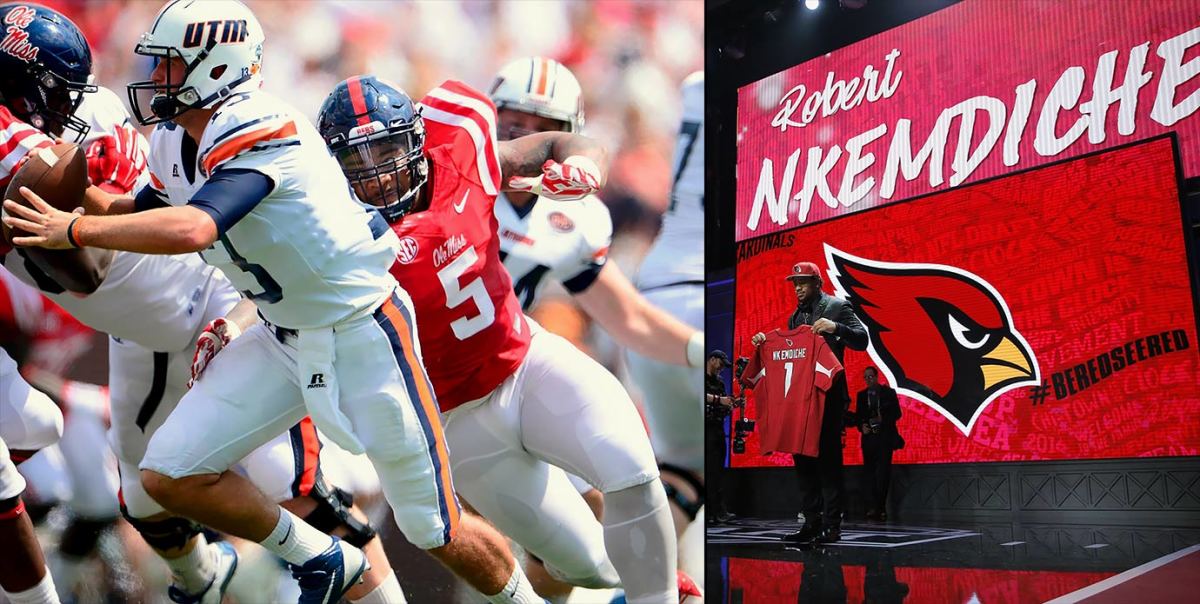
The Cardinals get one of the most dominant players in this class regardless of position, as Nkemdiche can be a real problem from any gap. His off-field issues will have to be vetted, as well as the concern that he doesn't get everything out of his potential on the field, but if Bruce Arians can corral Nkemdiche's talent as he did with Tyrann Mathieu, Arizona now has a run-stopping monster with the ability to rush the passer no matter where he is on the line.
30. CAROLINA PANTHERS: Vernon Butler, DT, Louisiana Tech — GRADE: A
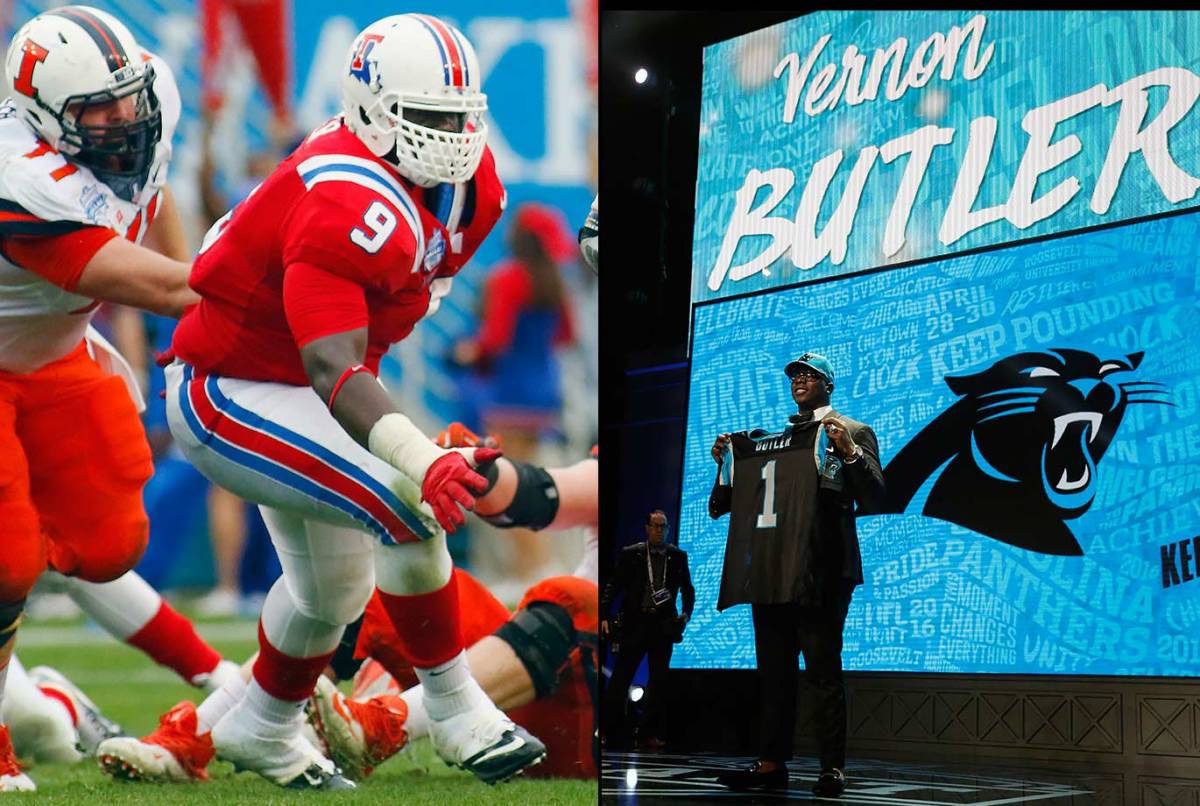
Losing Josh Norman means that the Panthers will need to reinforce their defense in other ways, because there wasn't an equivalent talent to Norman on the board at 30. Butler may have received small-school dings from some, but his tape screams NFL starter. He's 6' 4" and 323 pounds with great length, and he combines the speed and strength to take up any gap. He can also hold his own in coverage, and he'll command double teams on most every play.
31. SEATTLE SEAHAWKS: Germain Ifedi, OT, Texas A&M — GRADE: C
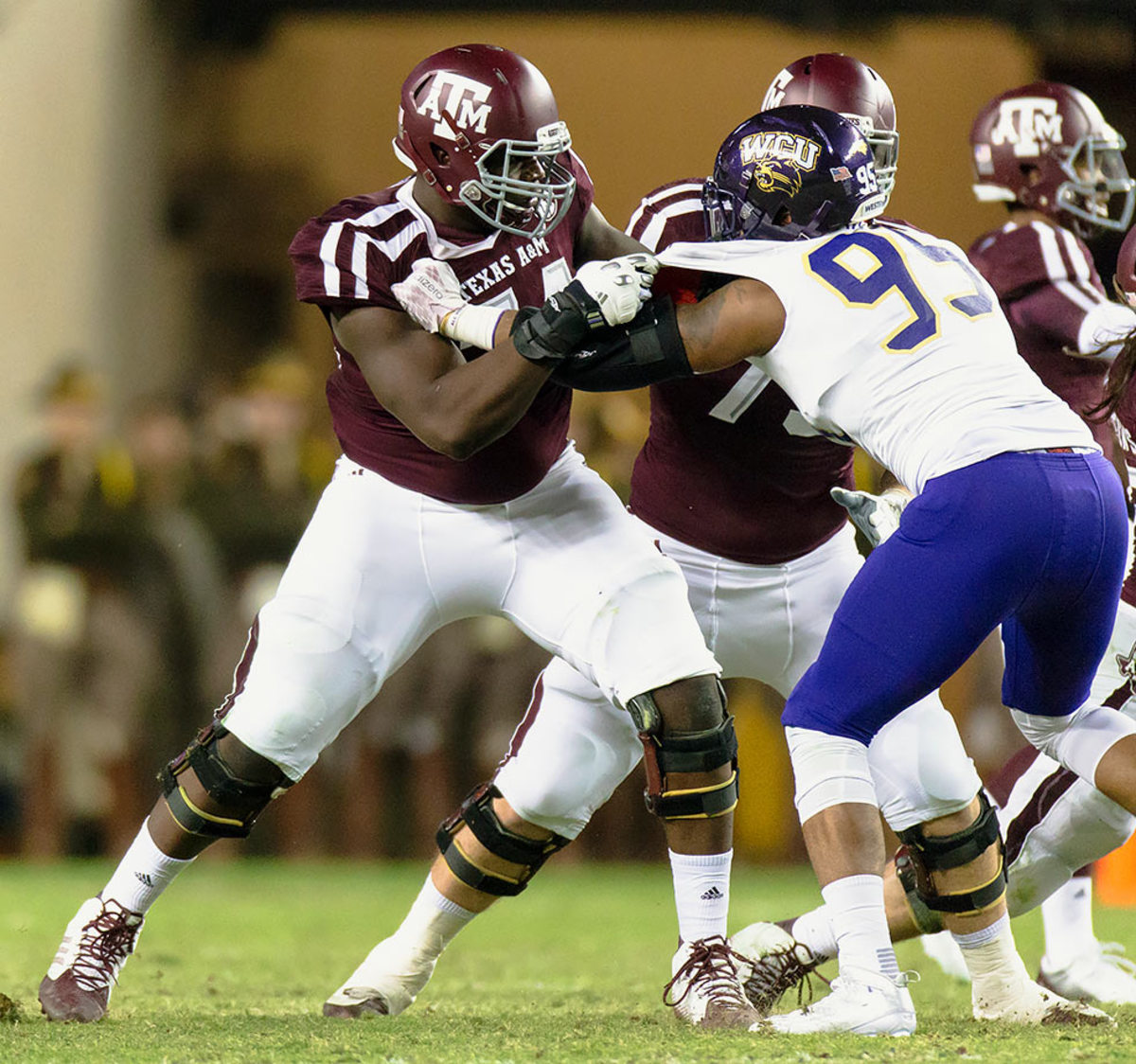
The Seahawks have had all sorts of issues with their offensive line over the last few seasons, so it's at least good that they're addressing it in the first round for the first time since they took Russell Okung in 2010. However, Ifedi is a bit of a tweener at this point: very strong in his run sets but a work in progress as a pass protector. Perhaps the idea is to move him inside or see how he'll work at right tackle, but this doesn't do much for the worst position group in the NFL.
The last time I heard a coach use those kinds of words to explain a quarterback acquisition, Brian Billick was asking Ravens fans to “take a leap of faith” in terms of Baltimore trading for the porked-up Scott Mitchell in 1999. “Trust me, Baltimore, I know quarterbacks,” Billick said, flashing some ill-timed confidence in the former Dolphins and Lions quarterback.
Kessler over Connor Cook, Dak Prescott, Cardale Jones and Kevin Hogan? Didn’t see that one coming from Cleveland, which once was in position to draft Carson Wentz at No. 2. “In Hue we trust” might be the new mantra in Cleveland, but I suddenly like Robert Griffin III’s chances to win the Browns' starting job a lot more than I did before this weekend.
• It can too often be easily tossed out there as a cliche, because teams love to talk about supplementing their rosters with tougher and more physical players. But the Lions certainly seem serious about that goal under new general manager Bob Quinn, who learned his NFL lessons in New England’s front office.
Detroit’s first four picks of the draft all added some nastiness to the roster, with first-round offensive tackle Taylor Decker of Ohio State, second-round defensive tackle A’Shawn Robinson of Alabama, third-round center Graham Glasgow of Michigan and fourth-round safety Miles Killebrew of Southern Utah playing with a physical, aggressive style. Killebrew especially sets a tone and packs a mean punch in the secondary, plus his nickname is “Killa.”
That will certainly work in the rough and tumble NFC North, where the outdoor Packers and Bears reside, and the Vikings have taken on the fierce intensity of head coach Mike Zimmer.
